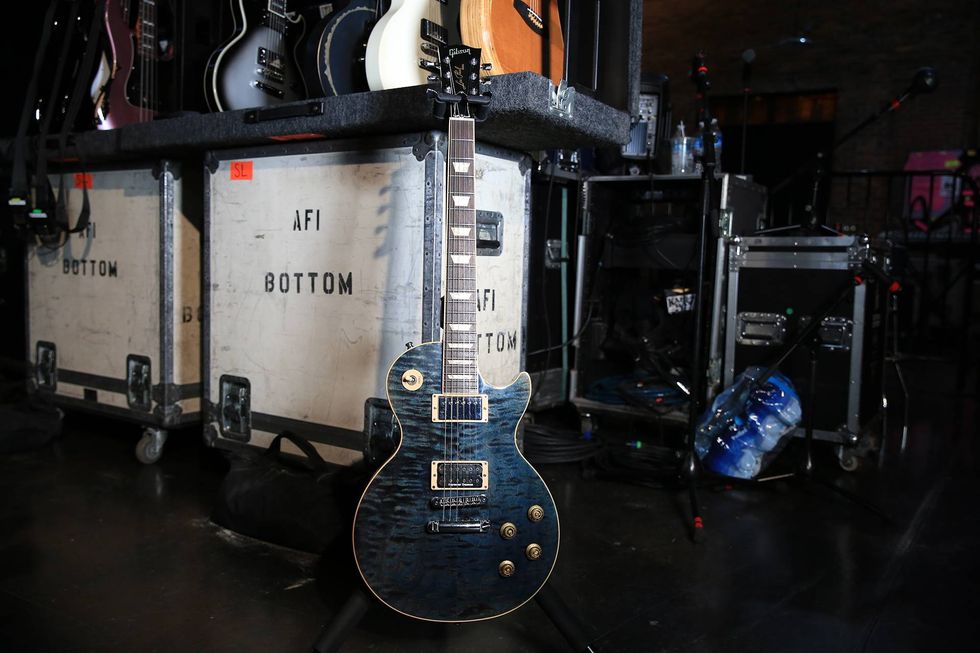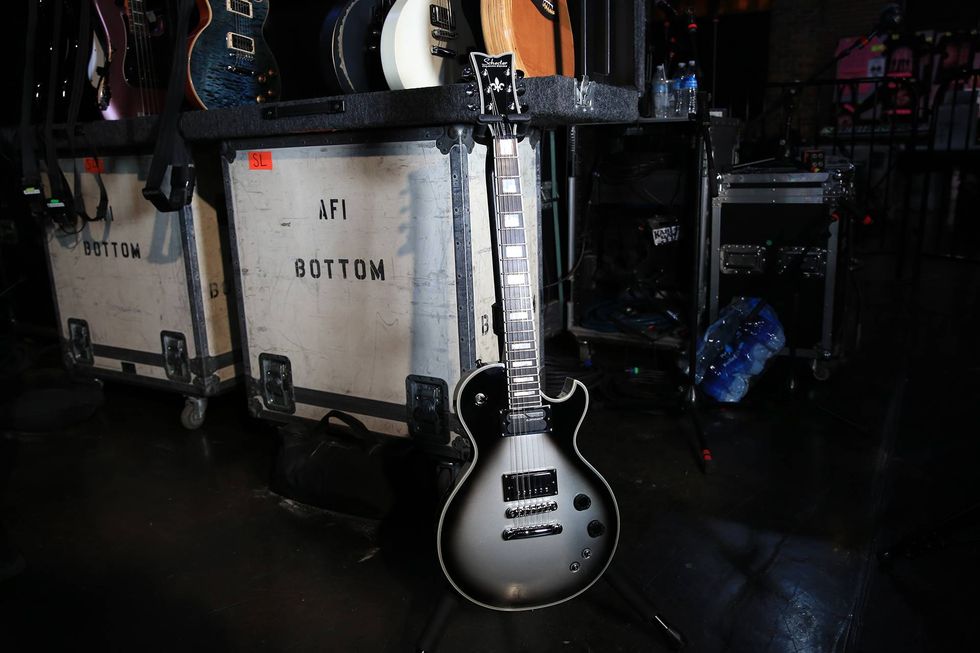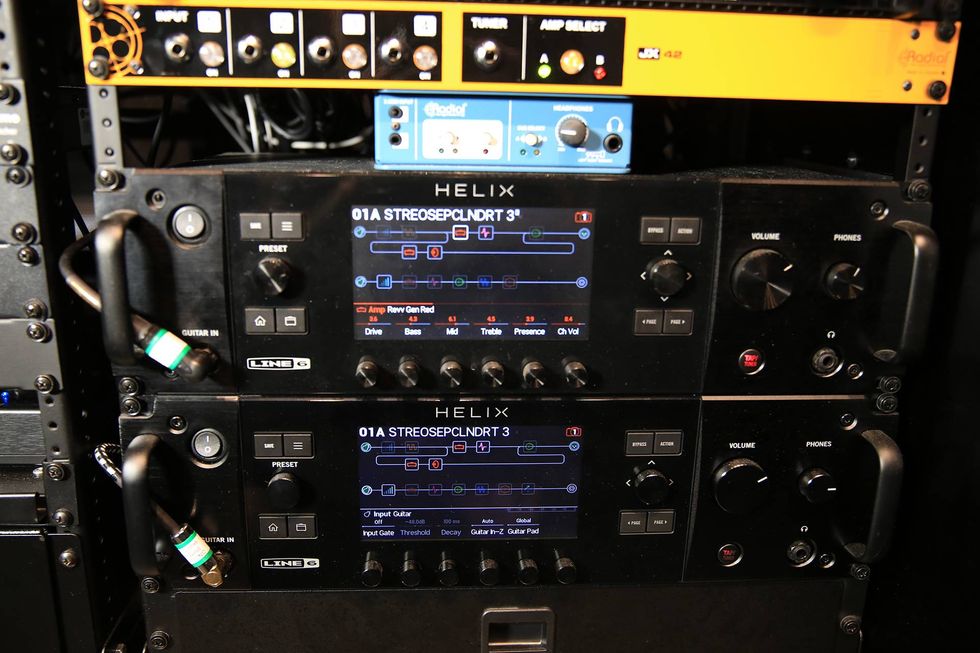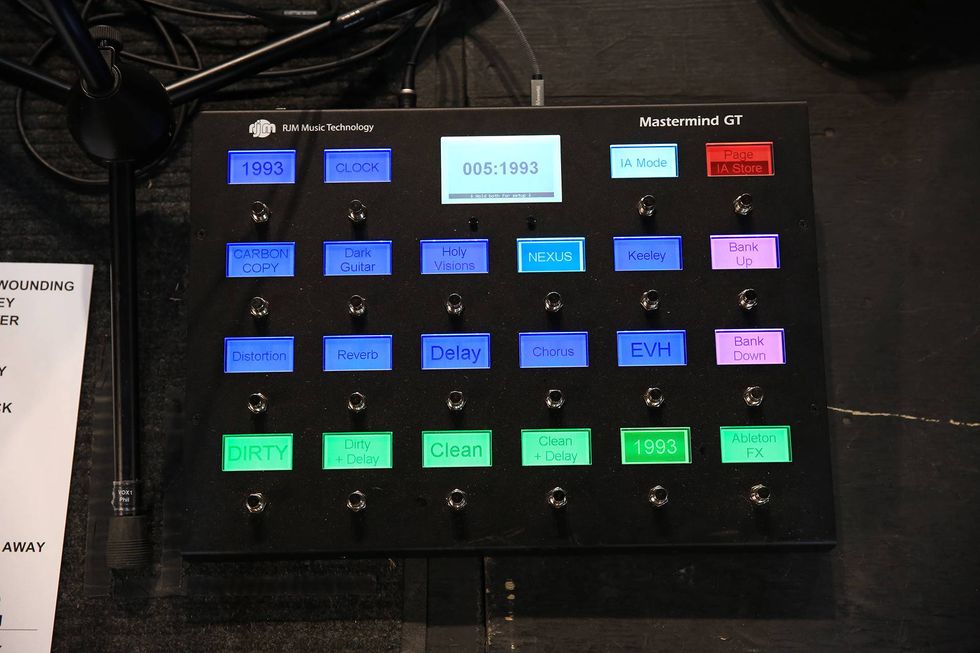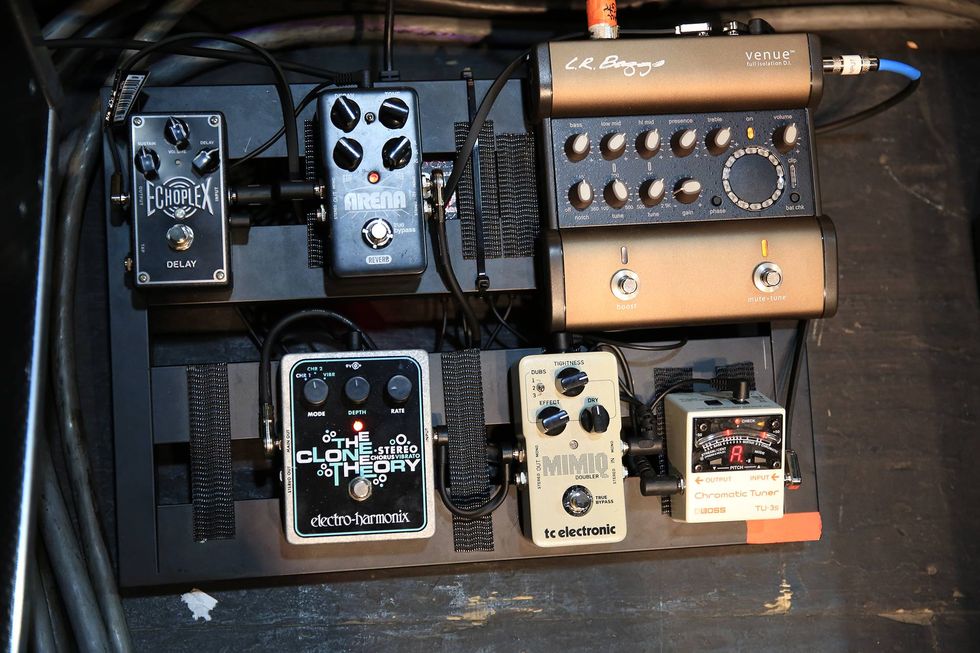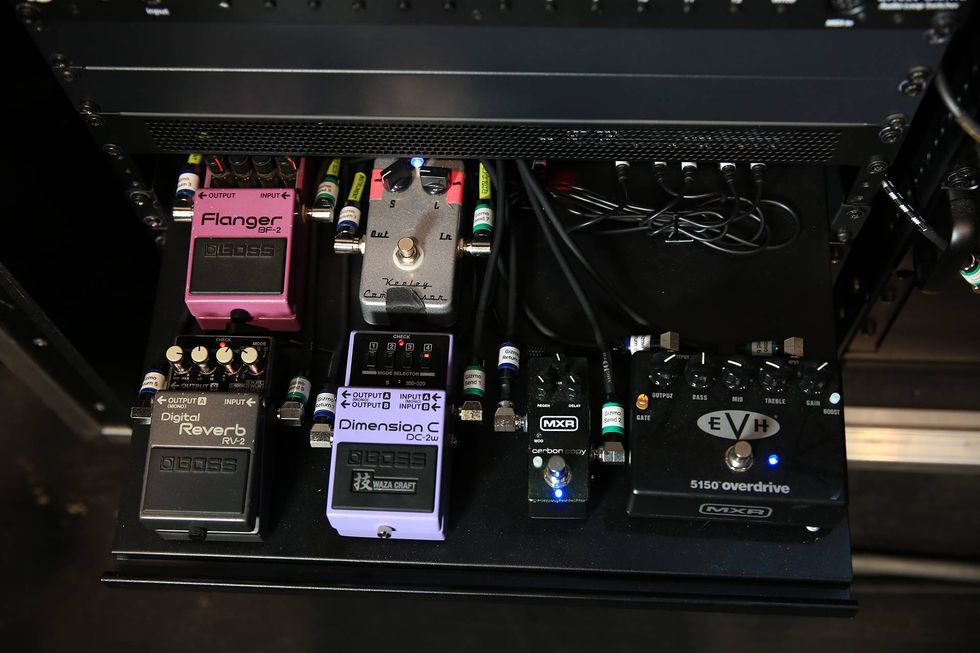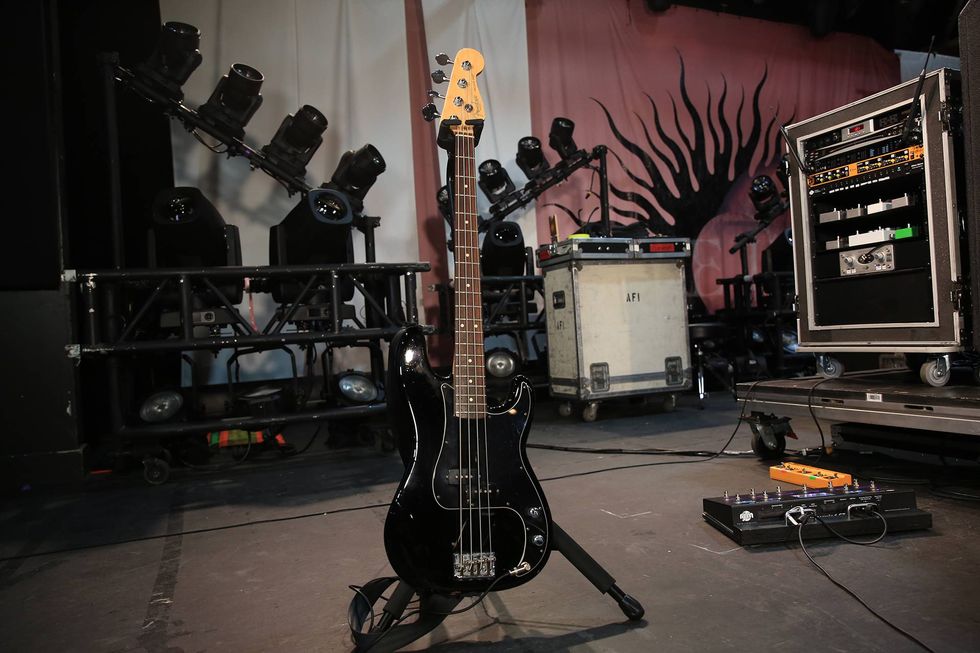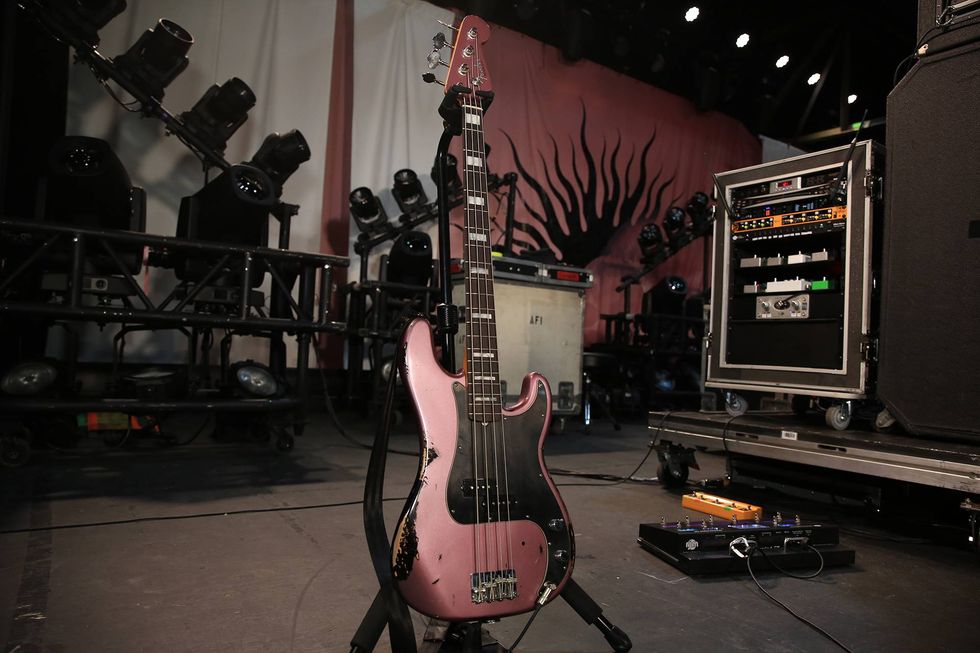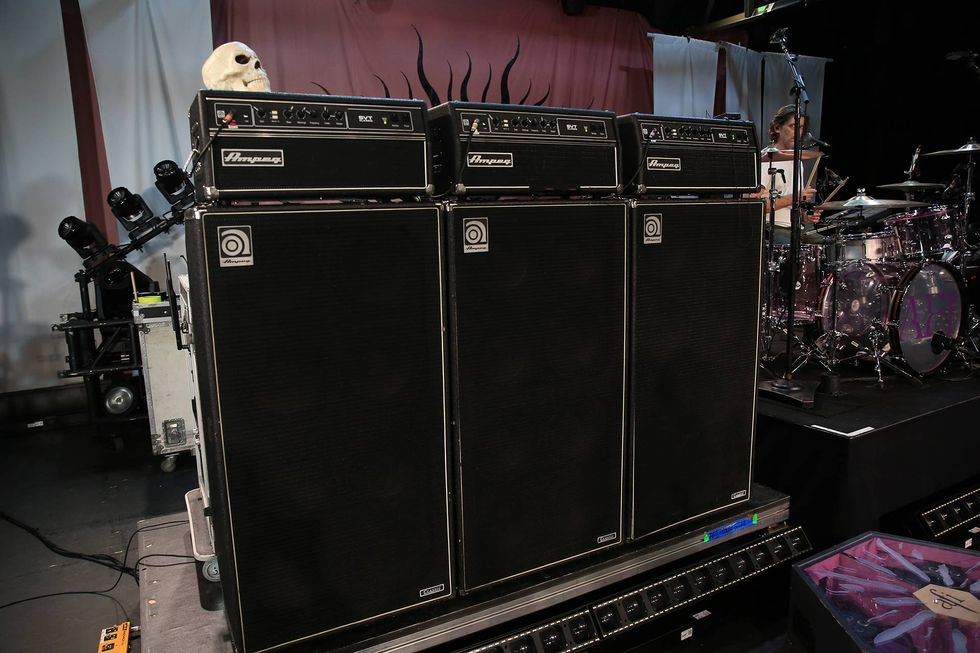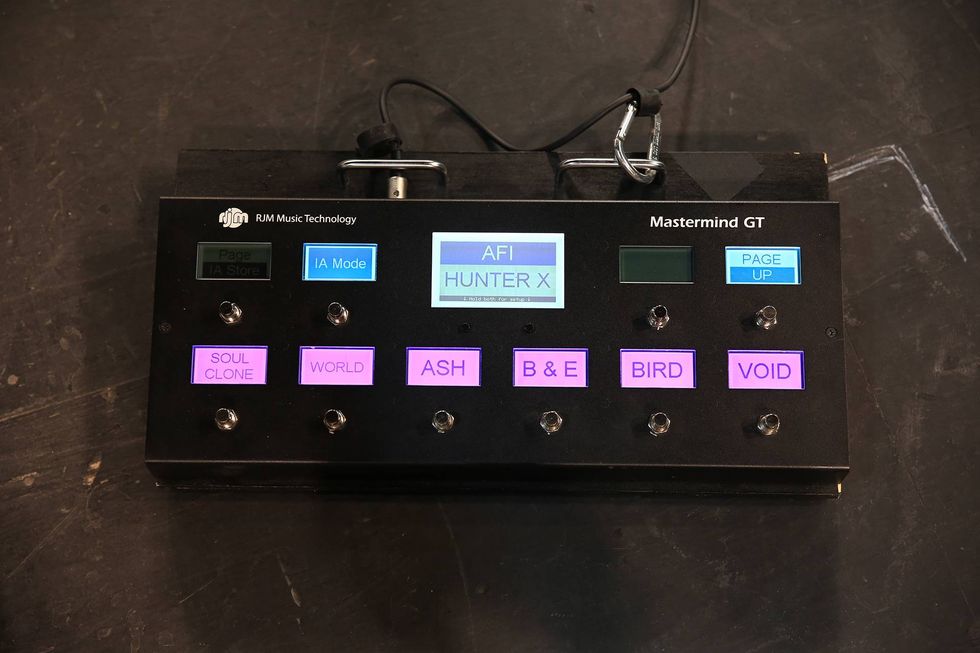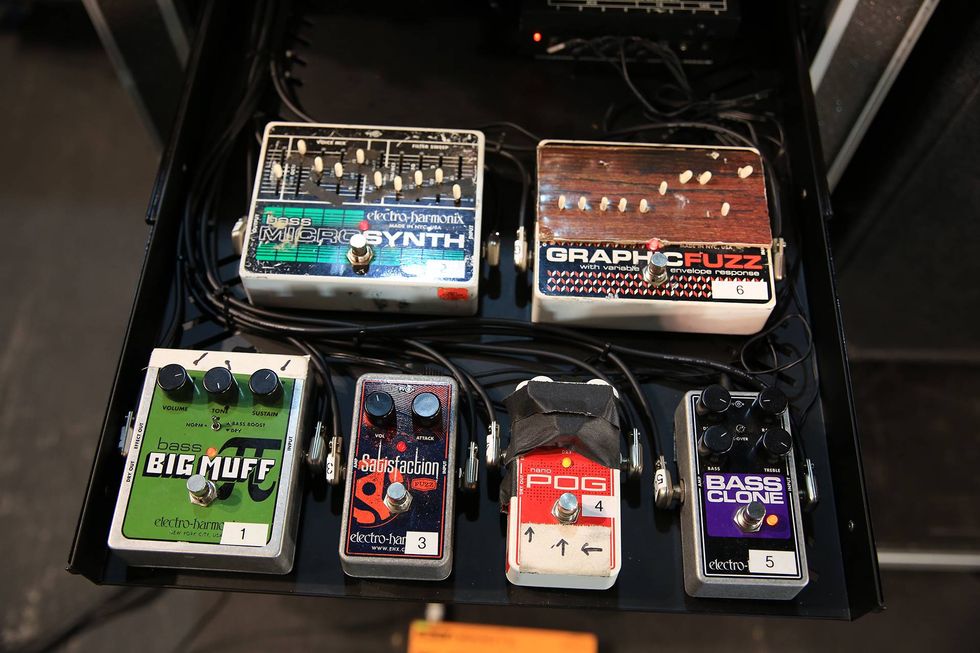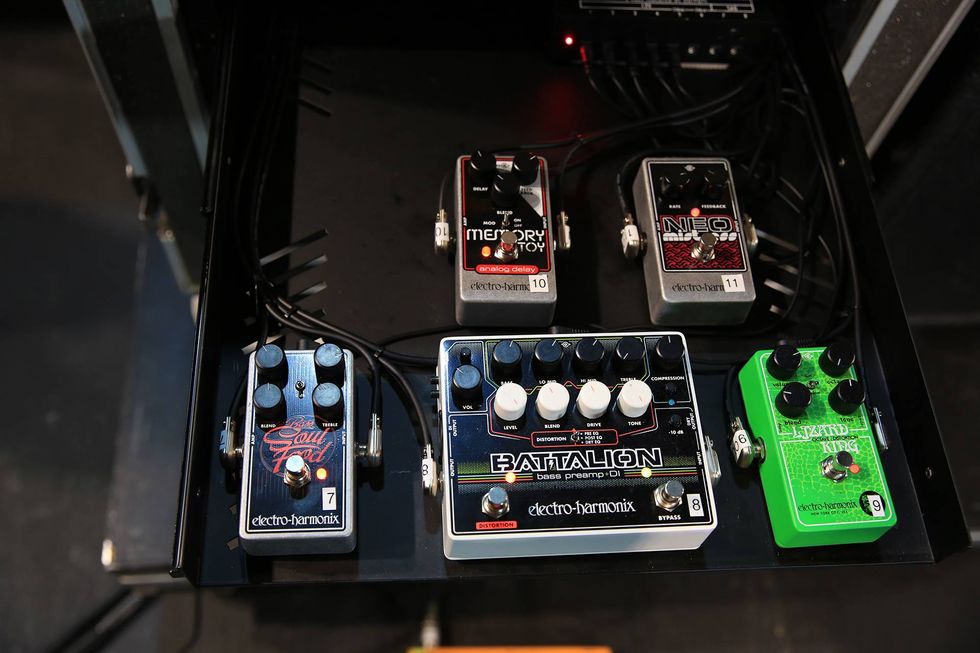Over the course of all these Rig Rundowns, we see a lot of pedalboards! Here are 13 of our favorites from the past year, from Billy Strings, Nile Rodgers, Rodrigo y Gabriela, Sunn O))), and more.
Billy Strings
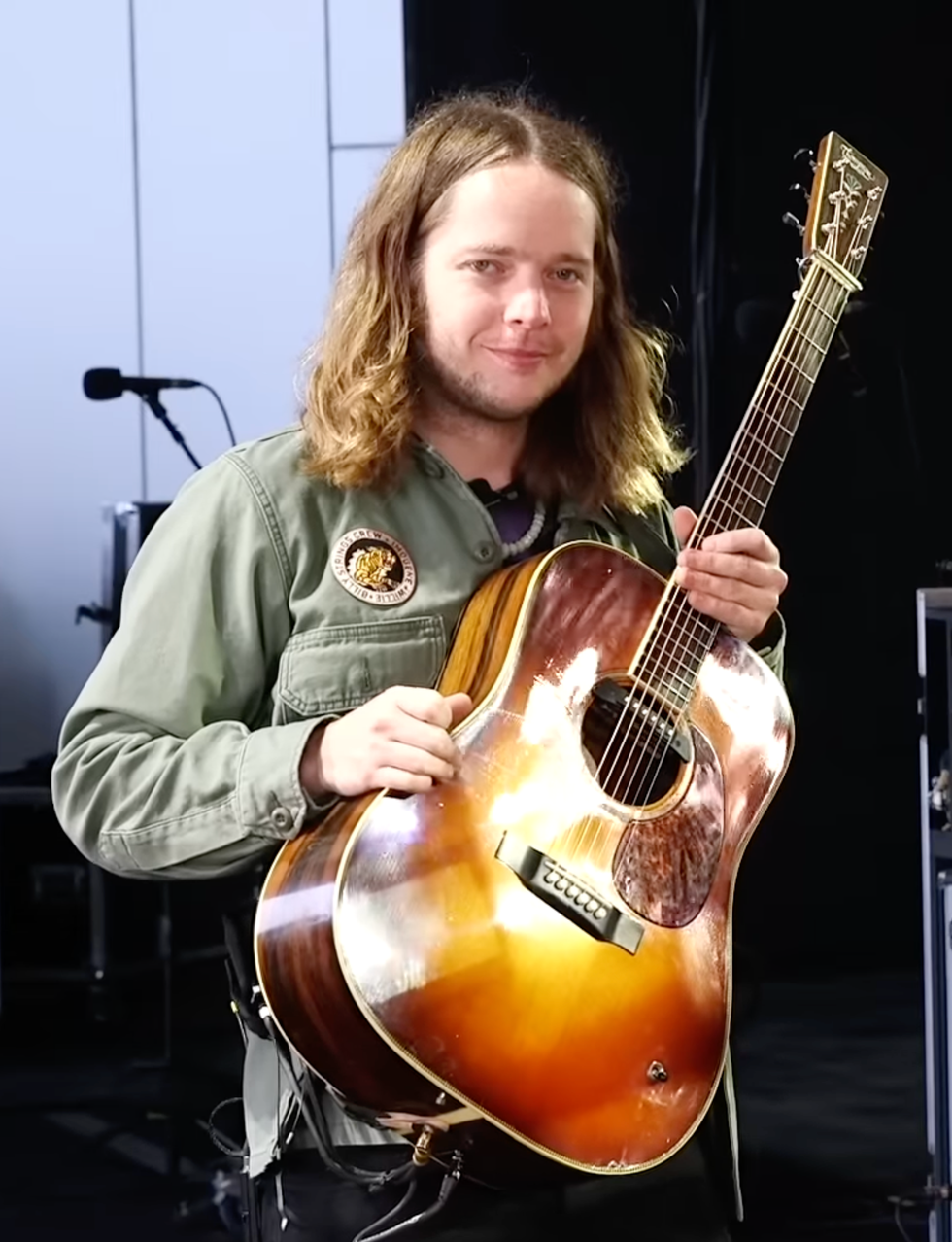
Billy Strings’ Pedalboard
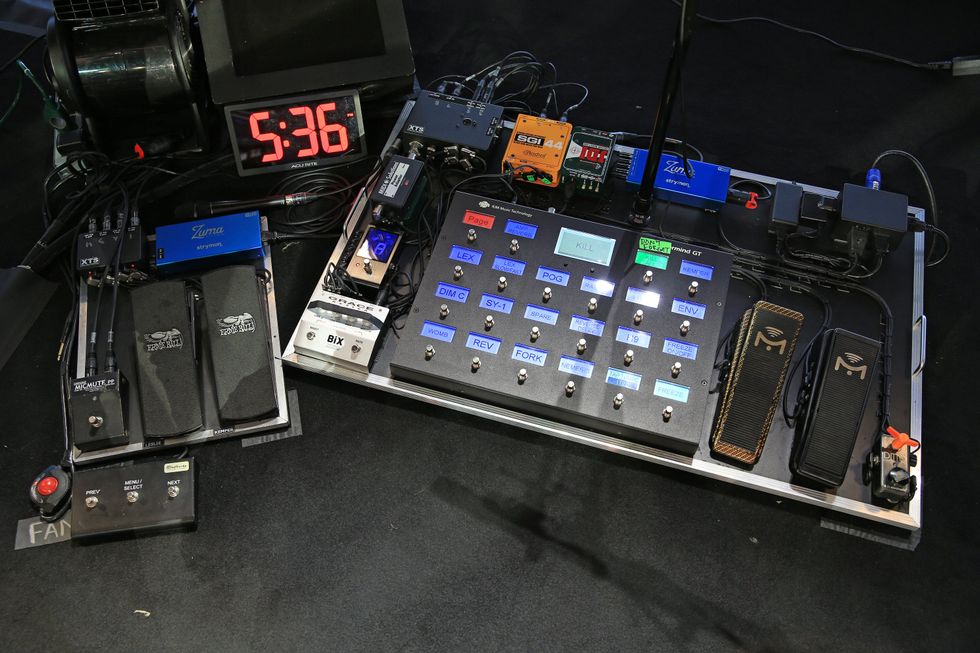
Bluegrass’ biggest ambassador has continued expanding his sound with more pedals and more modeling. When Billy wants to turn his acoustic into space dust, he’s got a hearty squadron of willing vaporizers. This is where Strings tap dances each night—an incredible feat given how much he’s already doing with his hands. A RJM Mastermind GT MIDI switcher is the brains of the operation as it engages all his pedals and the Kemper’s SLO-100 profile. The Grace Design BiX gives FOH a clean, pure acoustic sound. A pair of Mission Engineering SP-1 expression pedals handle manipulating time-based and modulation effects. His two Ernie Ball 40th Anniversary Volume Pedals bring in Leslie effects and the Kemper. A TC Electronic Ditto Looper remains on the board since our last encounter. A Peterson StroboStomp HD covers any on-the-fly tuning needs during his sets. Nashville’s XAct Tone Solutions built out this tonal headquarters, which features several of their custom devices and routing boxes. A couple Strymon Zuma units power everything on the floor, while a duo of Radial boxes helps organize. (The SGI-44 talks to the rack-mounted JX44, and the JDI is a passive direct box designed to handle gobs of levels without any unwanted crunch.)
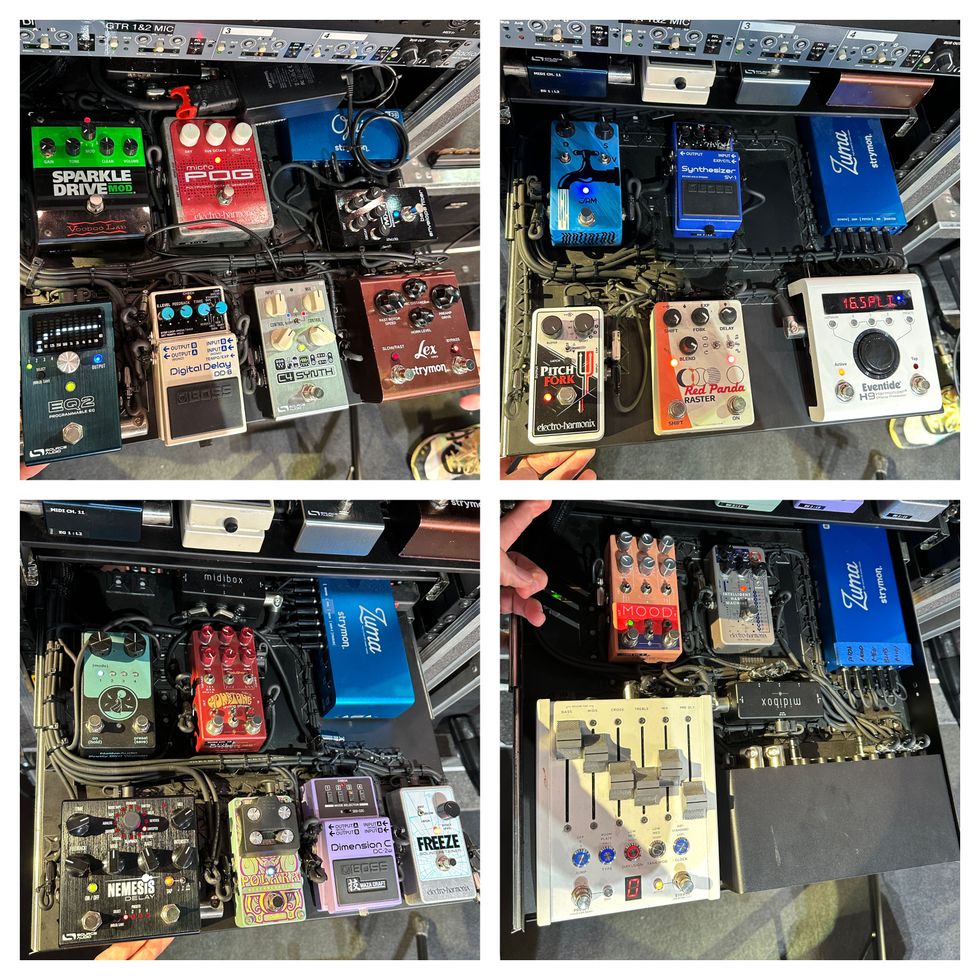
Here’s a peek behind the scenes, into the inside of Strings’ rack. Starting at the top left, he has a Voodoo Lab Sparkle Drive, Electro-Harmonix Micro POG, MXR Bass Envelope Filter, Source Audio EQ2, Boss DD-8 Digital Delay, Source Audio C4 Synth, and a Strymon Lex. A Strymon Ojai powers the pedals in this drawer. Moving to the right, he has a Jam Pedals Waterfall, Boss SY-1 Synthesizer, EHX Pitch Fork, Red Panda Raster, and an Eventide H9. All of these gizmos are powered by a Strymon Zuma. Going down to the bottom left, Strings assembles this drawer with a NativeAudio Pretty Bird Woman, a Chase Bliss Wombtone, Source Audio Nemesis, DigiTech Polara, Boss DC-2W Dimension C, and an EHX Freeze. Another Strymon Zuma powers all these creatures. The final drawer houses a Chase Bliss Audio Mood, EHX Intelligent Harmony Machine, and a Chase Bliss Automatone MKII Preamp. Everything comes to life with a final Strymon Zuma.
Blu DeTiger
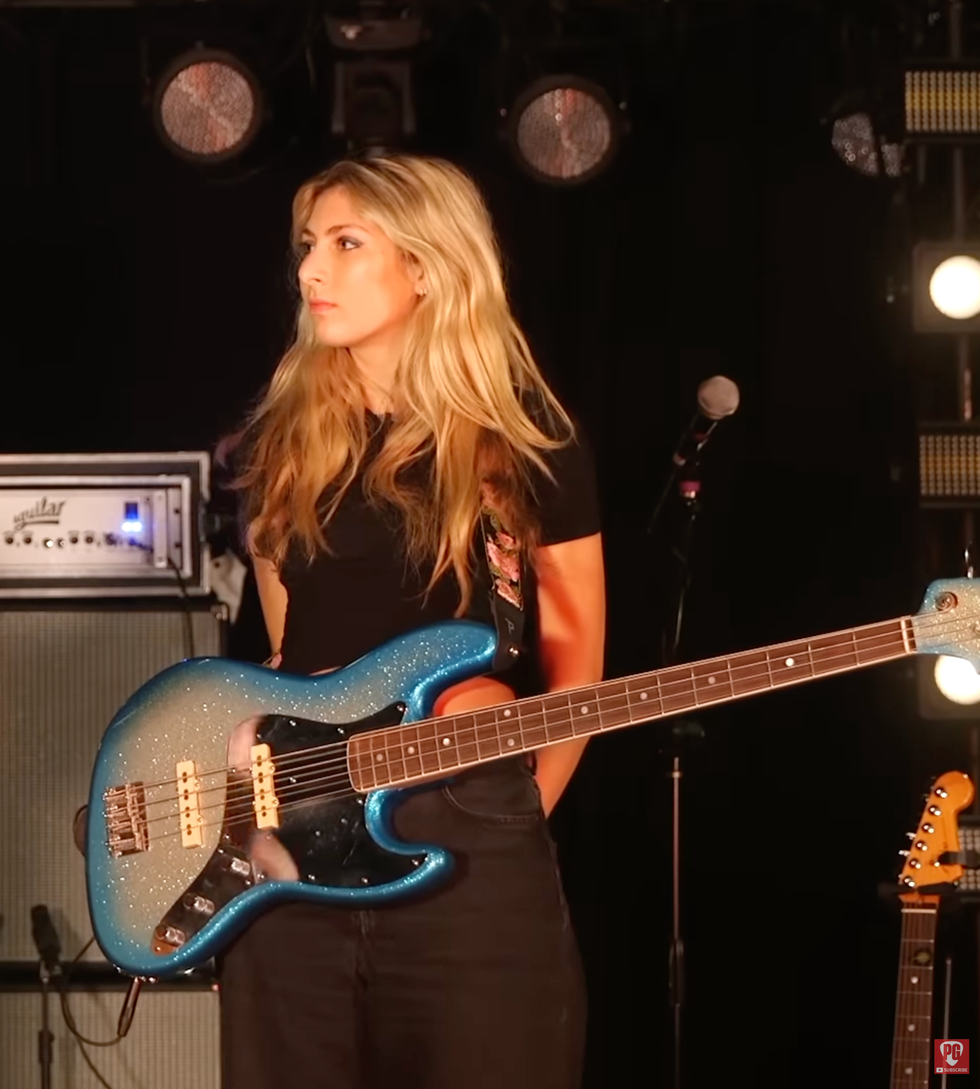
Blu DeTiger’s Pedalboard
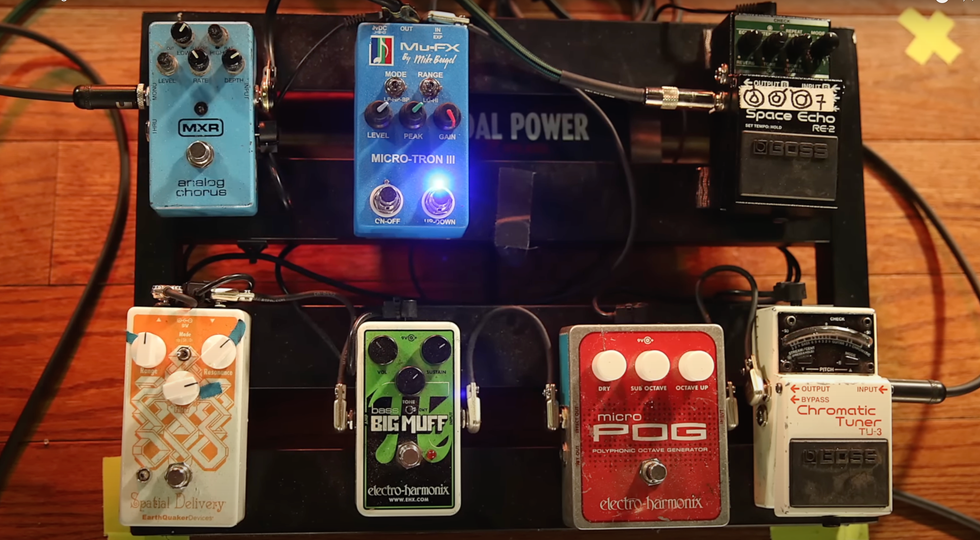
“I haven’t gone through that phase of using crazy pedals yet. Live, I just really love the sound of a clean bass tone,” admits bassist DeTiger. Whether slapping on TikTok, headlining solo tours, performing with Jack Antonoff and Olivia Rodrigo, or improvising over her DJ set, this board represents her go-to gear. Each piece in this cast of characters gets used for specific moments. She uses the octave up on the Electro-Harmonix Micro POG for “shredding” and the sub octave setting to “change the vibe for a second.” The Electro-Harmonix Bass Big Muff enhances some of the POG’s shadings with added stank. The EarthQuaker Devices Spatial Delivery is used for the funky intro to “enough 4 u,” her collaboration with Chromeo. She prefers the Spatial Delivery to the Mu-FX Micro-Tron III (which doesn’t get used at all now) and the MXR Analog Chorus is engaged for one instance. The Boss RE-2 Space Echo sees action with the Strat for “Sonic Youth freakouts” during “Kinda Miss You.” A Boss TU-3 Chromatic Tuner keeps all four strings in line and a Voodoo Lab Pedal Power 2 Plus provides the volts.
Christone “Kingfish” Ingram
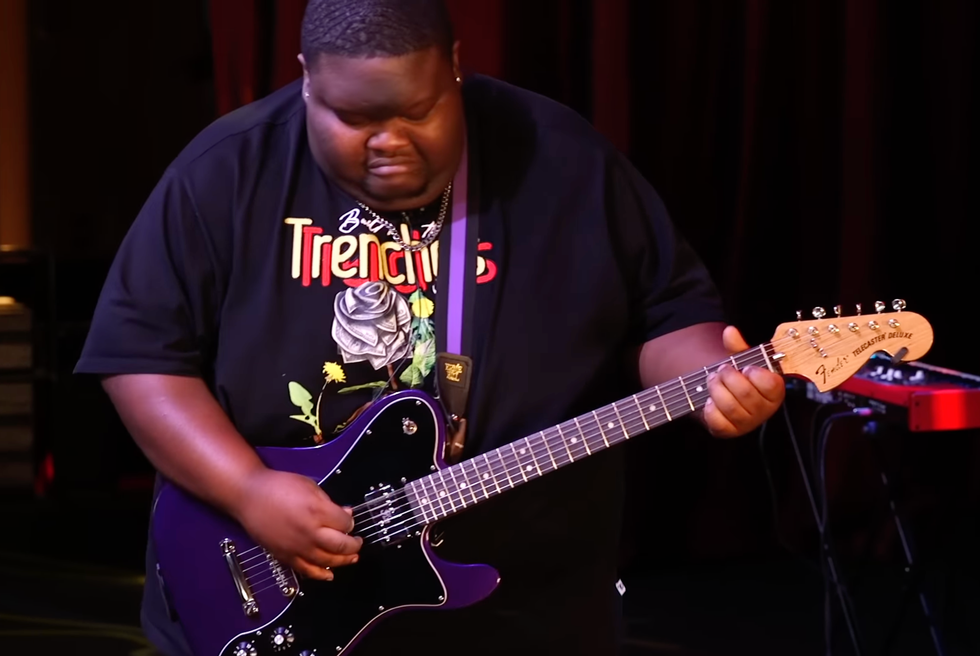
Kingfish’s Pedalboard
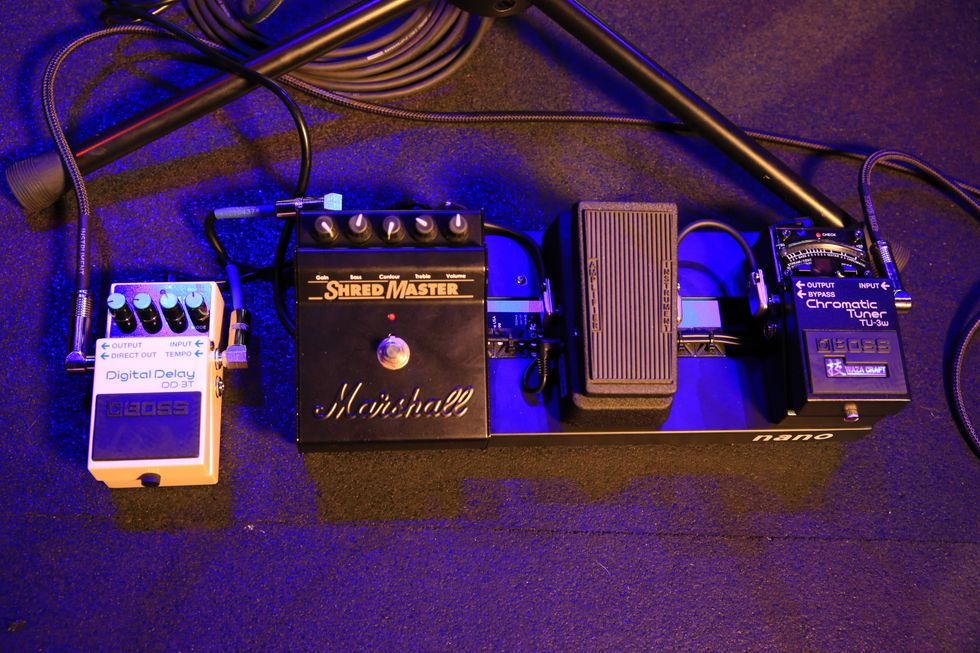
Christone “Kingfish” Ingram is well on his way to becoming the blues’ newest 6-string ruler and he doesn’t use much gear to get the job done. Kingfish’s signal starts with a Shure BLX4 Wireless Receiver, which hits a Boss TU-3W Tuner. From there, the route is a Dunlop Cry Baby Mini Wah, a Marshall Shredmaster, and a Boss DD-3 Delay, all powered by Strymon. The pedals live on a Pedaltrain Nano board and were assembled by Barry O’Neal at XAct Tone Solutions.
Emily Wolfe
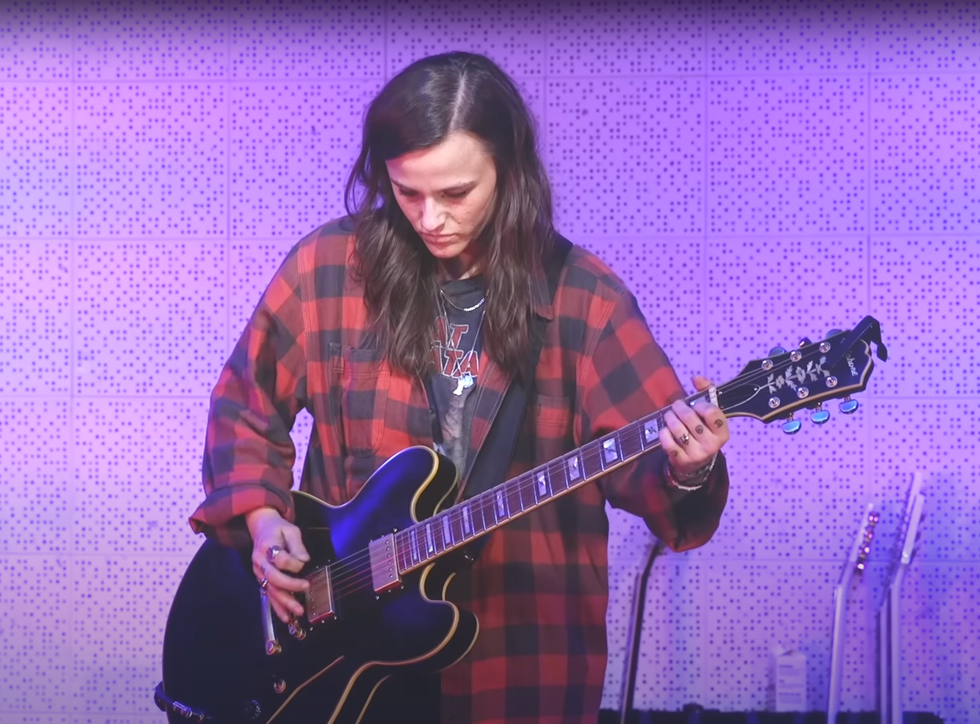
Emily Wolfe’s Pedalboard
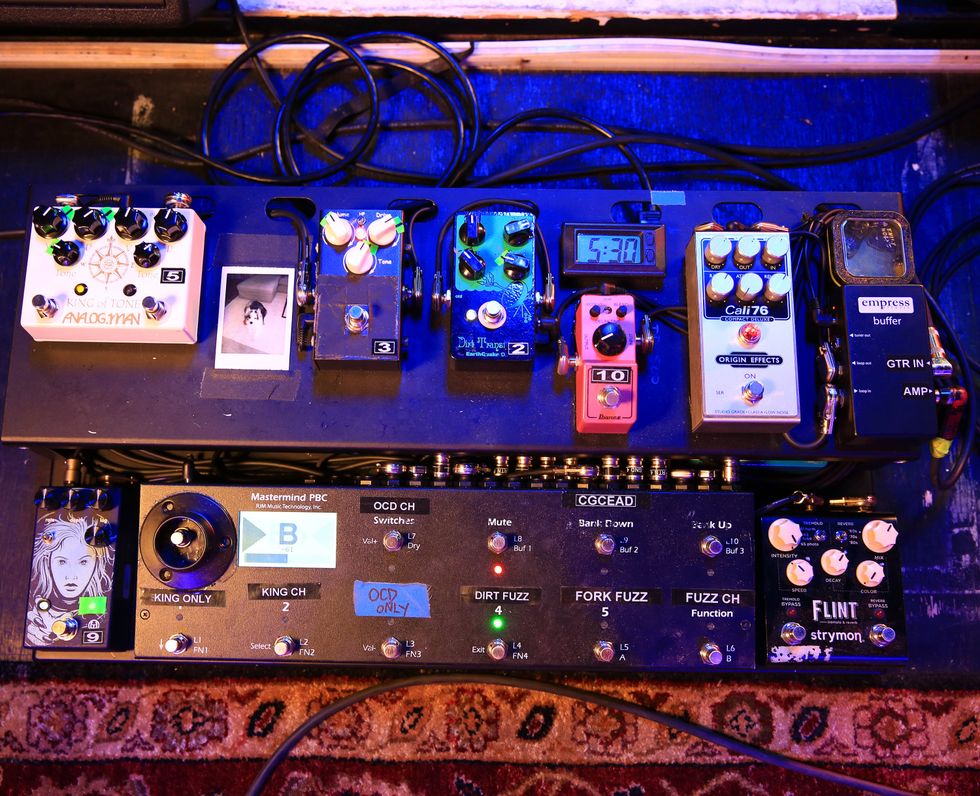
“If I get a new piece of gear, I have to figure out every single part of it before I can really use it,” the shreddin’ Texan confessed to PG while talking about her 2021 album, Outlier. That sensible curiosity has led her to dialing in precise parameters on the pedals and creating colossal combos with singular gain staging. Her silver bullet is the EarthQuaker Devices Tentacle Analog Octave Up, running into a Fulltone OCD, and an MXR Six Band EQ. Wolfe claimed to PG, “That’s the sound that belongs to me.” The sequence creates a “crazy fuzztone” from the overdrive. Then she uses the EQ to reduce some of the lows and boost the mids for a sound she says will get her guitar to cut through any mix.
Other spices in the rack include an Analog Man King of Tone, an EarthQuaker Devices Dirt Transmitter fuzz, an Ibanez Analog Delay Mini, an Origin Effects Cali76 Compact Deluxe, a Walrus Audio Julia, and a Strymon Flint. The Empress Buffer puts the Delay Mini and Flint outside the RJM Mastermind PBC’s control.
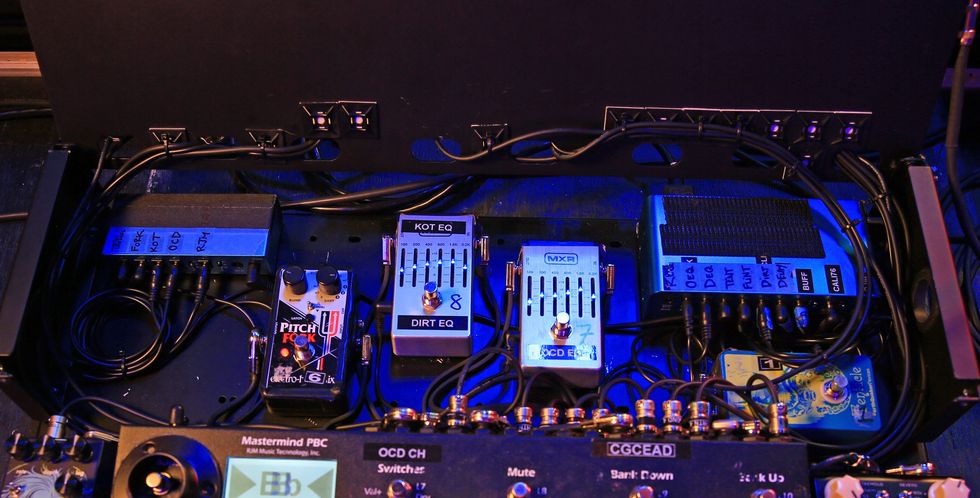
Underneath the hood, Wolfe has tucked in a pair of MXR M109S Six Band EQ pedals (one hitting the King of Tone and the other hitting the OCD), an Electro-Harmonix Pitch Fork, the EarthQuaker Devices Tentacle, and a couple of Strymon power supplies (Ojai and Zuma).
Hermanos Gutiérrez
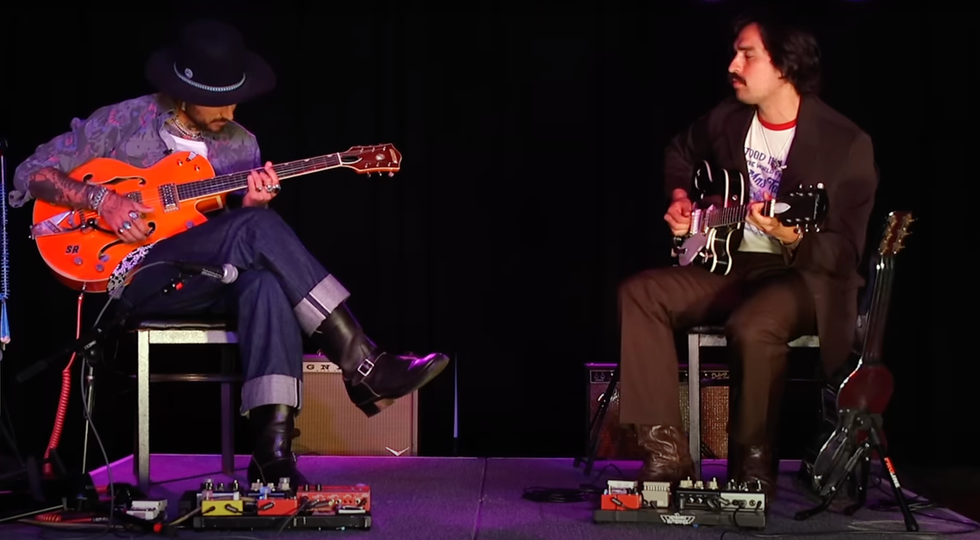
Estevan Gutiérrez’s Pedalboard
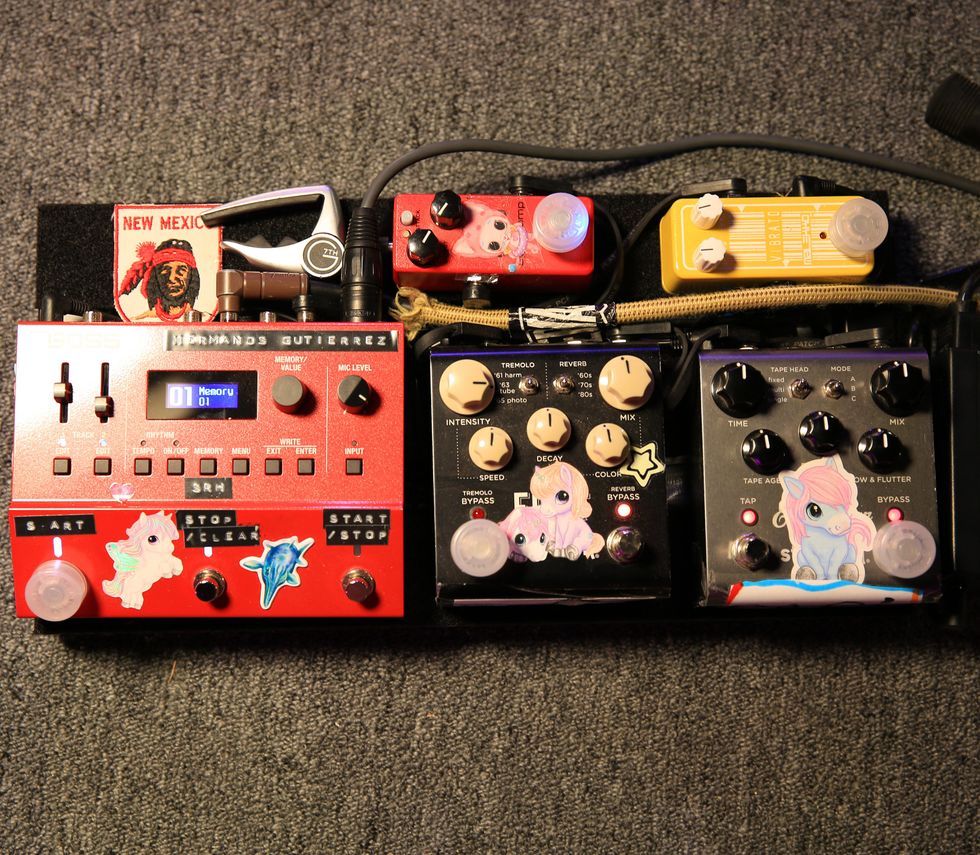
The Gutiérrez brothers pack light. You can see that Estevan Gutiérrez utilizes nearly every square inch of his pedalboard. Overlaps between the brothers’ boards include the MXR Dyna Comp Mini, the Strymon Flint, and the Strymon El Capistan. You might think their setup is basic now, but they used to play sans pedals. Eventually, Estevan discovered the Strymon El Capistan, and their sound was never the same. “I remember that day,” he recounted to PG about first playing the pedal. “I fell in love. I knew it was gonna change something in our sound.” As soon as he purchased the El Capistan, he called his brother and said, “You have to buy this. This is gonna be next level for us.”
The remaining effects for Estevan include a Malekko Omicron Vibrato, a Boss RC-500 Loop Station, and a Boss TU-3 Chromatic Tuner (off the board) keeps his Gretsch in check. Lastly, you’ll notice a G7th Performance 3 ART Capo on the pedalboard, too.
Alejandro Gutiérrez’s Pedalboard
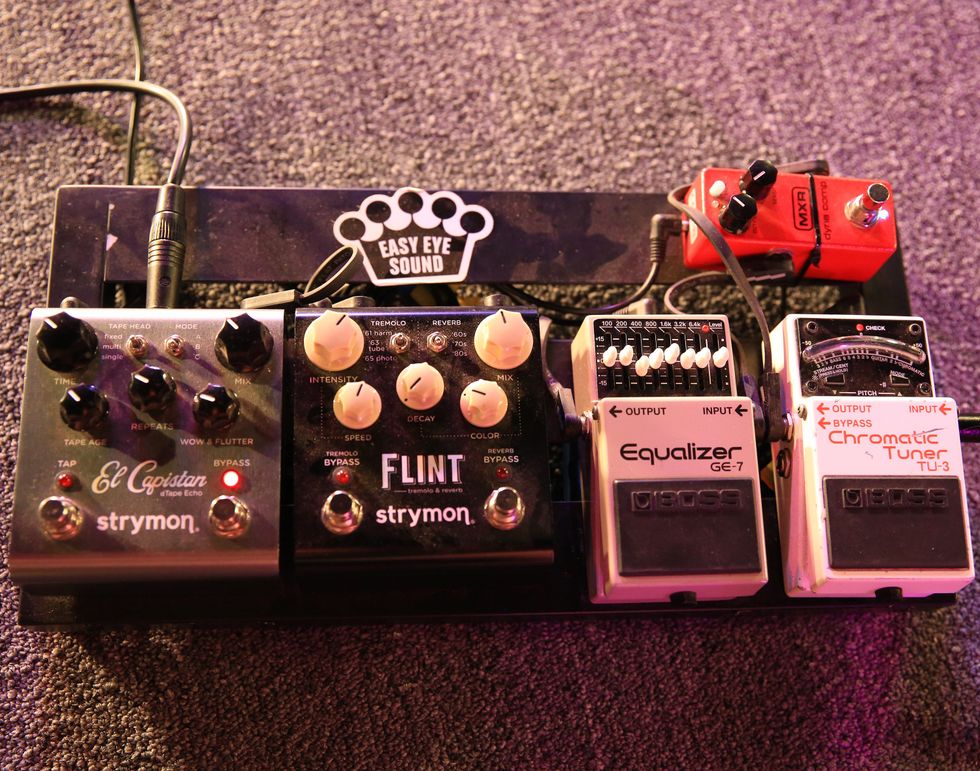
Alejandro, who plays guitar and lap steel, relies on this compact board that holds a MXR Dyna Comp Mini, a Boss GE-7 Equalizer, a Strymon Flint, and the influential Strymon El Capistan. While Estevan discovered the El Cap and unlocked its magic for Hermanos Gutiérrez, Alejandro has molded it to his sound in different ways. “I use it as a layer,” he explains. “Really subtle. My brother uses it more as a delay. He has this horse sound, like this galloping sound he can create with his slapping, which only he can do.” A Boss TU-3 keeps his guitars in line.
Nile Rodgers
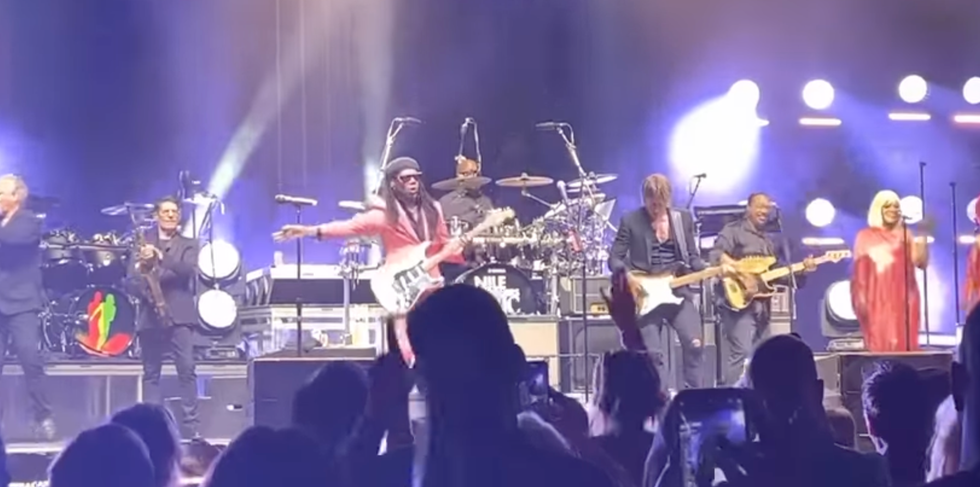
Nile Rodgers’ Pedalboard
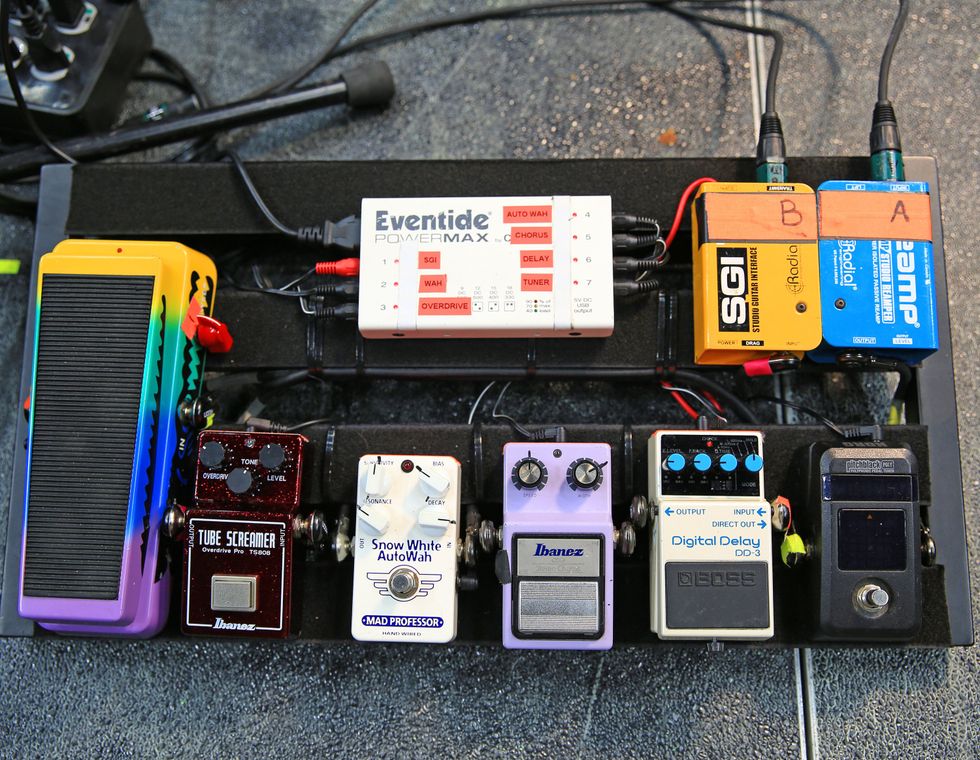
The Hitmaker doesn’t drown in effects. Instead, Rodgers maintains a simple, sophisticated signal chain into his Fender Hot Rod Deville. Rodgers uses a Pedaltrain Classic 2, loaded up with an Eventide PowerMax Power Supply. The Eventide feeds a Korg Pitchblack Chromatic Tuner, a Boss DD-3 Digital Delay, an Ibanez CS9 Stereo Chorus, a Mad Professor Snow White AutoWah, an Ibanez TS808 40th Anniversary Tube Screamer, and a Jam Pedals Wahcko Wah Pedal. The stompboxes are all wired together with Reference Laboratory RIC-01 cabling.
Rodrigo y Gabriela
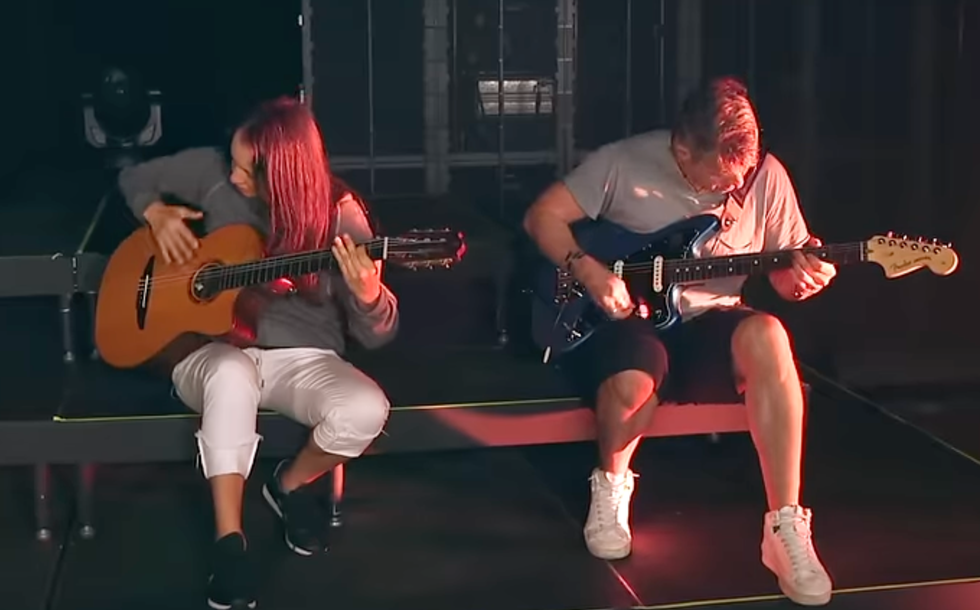
Rodrigo Sánchez’s Pedalboard
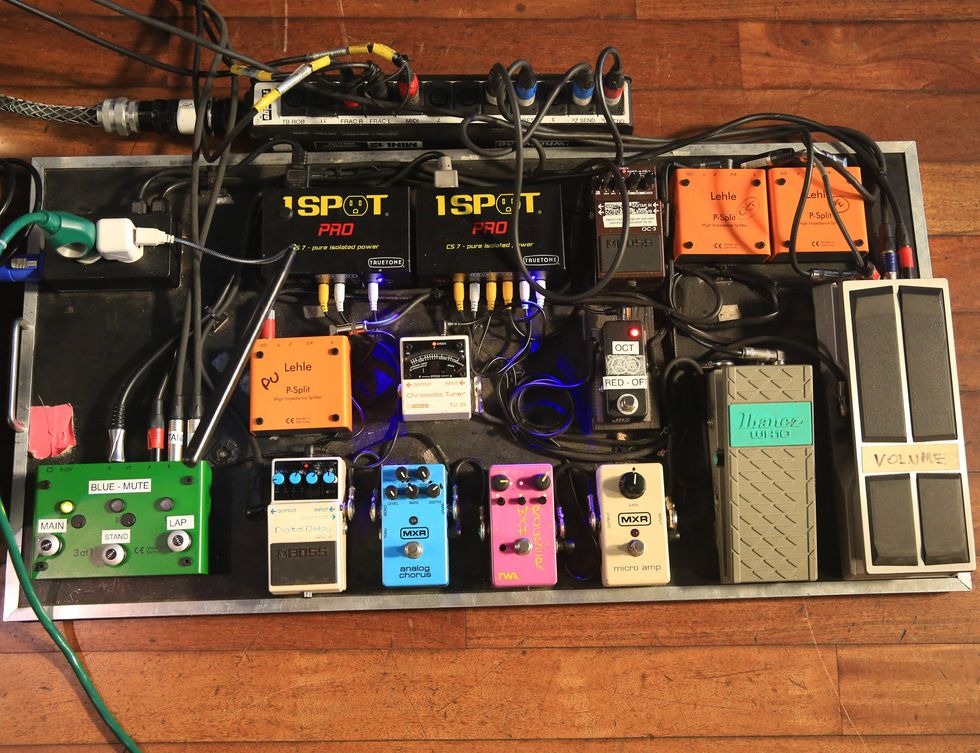
The eclectic, trailblazing guitar maestros blend acoustic and electric sounds in their respective rigs. The pickup return from Sánchez’s wireless rack goes to the volume pedal via a Lehle 3at1 switcher, then out to a Lehle P-Split signal splitter. The direct out from the P-Split goes to another Lehle splitter, while the ISO line out runs to the rest of the pedals before ending up at a Fractal. (The ISO out of the first splitter goes to the JHS Mini A/B pedal into the Boss OC-3, then to a separate channel on the desk.) His tone-shapers include an MXR Micro Amp, TWA WR-3 Wah Rocker, MXR Analog Chorus, and a Boss DD-3 Digital Delay. He stays in tune thanks to a Boss TU-3S Chromatic Tuner. It’s all powered by a pair of Truetone 1 Spot Pro CS7 power supplies.
Gabriela Quintero’s Pedalboard
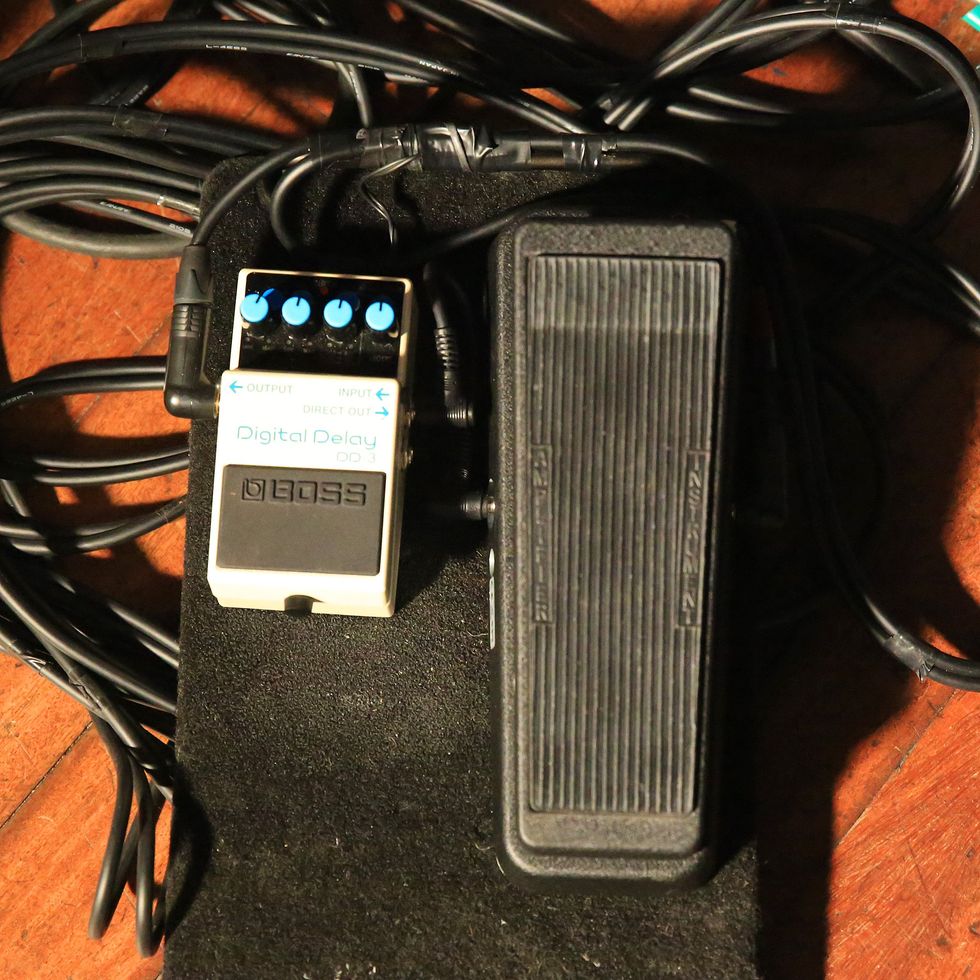
It doesn’t get much simpler than this. Quintero’s pedalboard funnels the acoustic’s first two channels—the undersaddle and the body’s piezos—into a stereo volume pedal. From there, they run through a Dunlop Cry Baby and a Boss DD-3 Digital Delay. The signal is then split, with the first side going back to the DI, and the second running through a Dunlop volume pedal into a Boss OC-3 for an extra bottom octave.
Sunn O)))
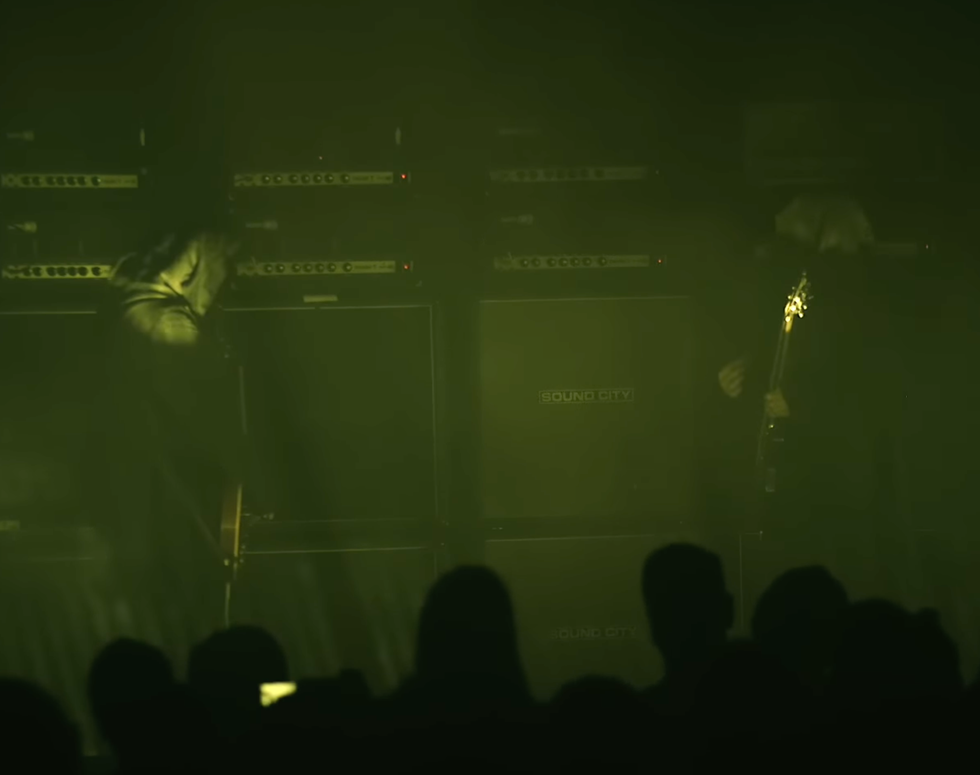
Stephen O’Malley’s Pedalboard
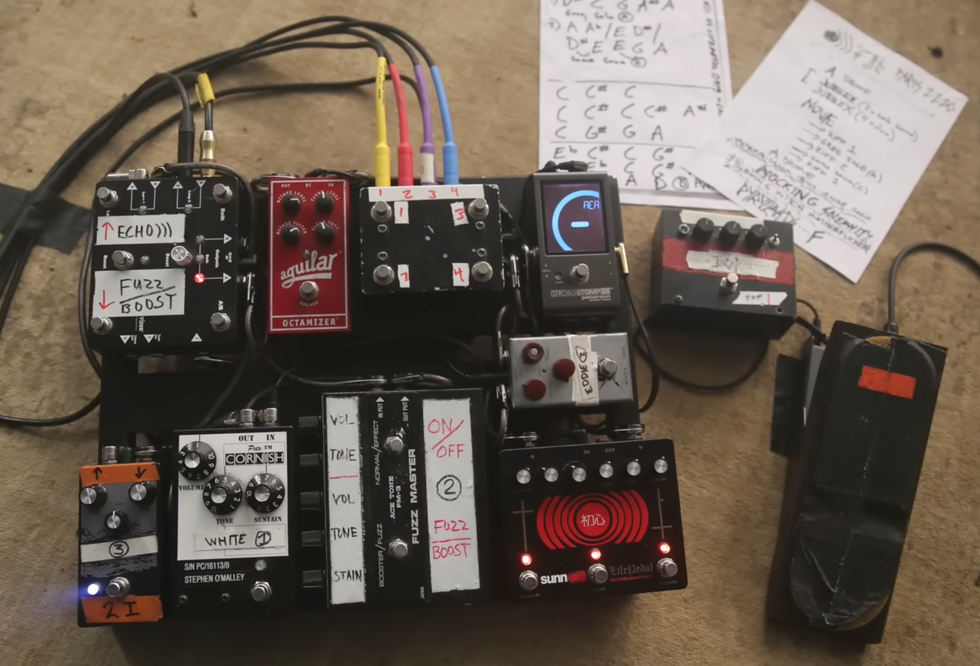
Drone metal overlords Stephen O’Malley and Greg Anderson use volume as an aesthetic. “My concept in playing this music for tone involves many, many, many different gain stages that are all intonated differently depending on the pitch of the sound,” O’Malley told us last year. “There are slight shades of color saturation or grain as if it’s a paint—the shorter bandwidth color gradation or the density of the paint.” All these subtle sweeps of saturation, sustain, and feedback are enlivened and exaggerated with Stephen’s pedal palette. His current collection of slaughtering stomps includes the band’s most recent collaboration with EarthQuaker Devices (Life Pedal V3), an Ace Tone FM-3 Fuzz Master, a Pete Cornish G-2, and an EarthQuaker Devices Black Ash. For subtler shadings, he has a J. Rockett Audio Designs Archer.
The EQD Swiss Things creates effects loops to engage the FM-3, G-2, or the Black Ash. In addition, he runs a Roland RE-201 Space Echo through the Swiss Things. O’Malley uses the Aguilar Octamizer as a “fun punctuation that comes on once in a while” that “abstracts the guitar into minimalist electronics.” The custom Bright Onion Pedals switcher keeps the amps in sync with phase controls and ground lifts. A Peterson StroboStomp HD keeps his Travis Bean in check. Off to the side of the board is a Keeley-modded RAT that initiated the band’s core sound, plus a Lehle Mono Volume. This circuit includes the heralded LM308 chip and was the basis for their partnership with EQD and the Life Pedal series.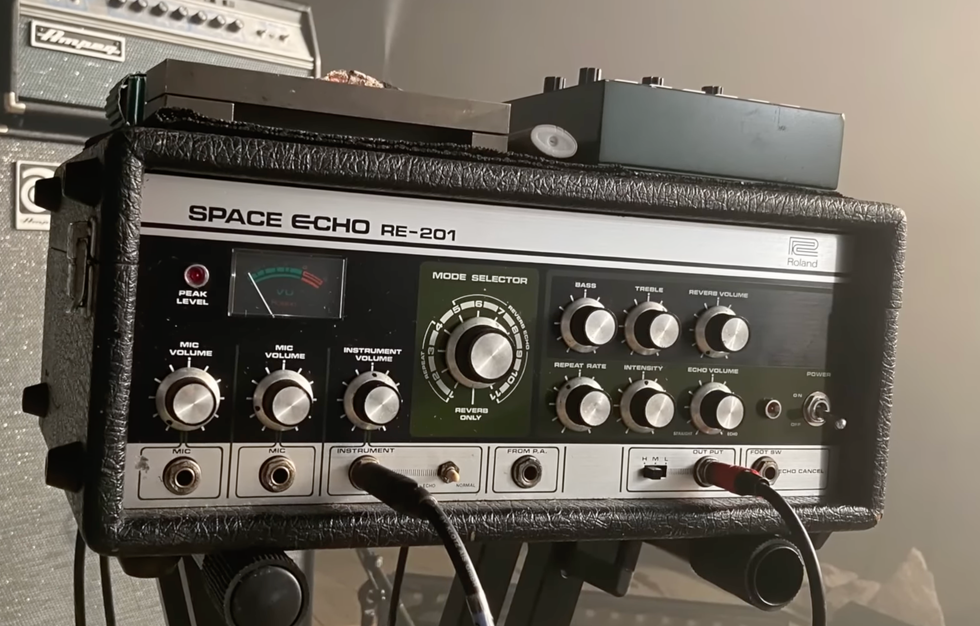
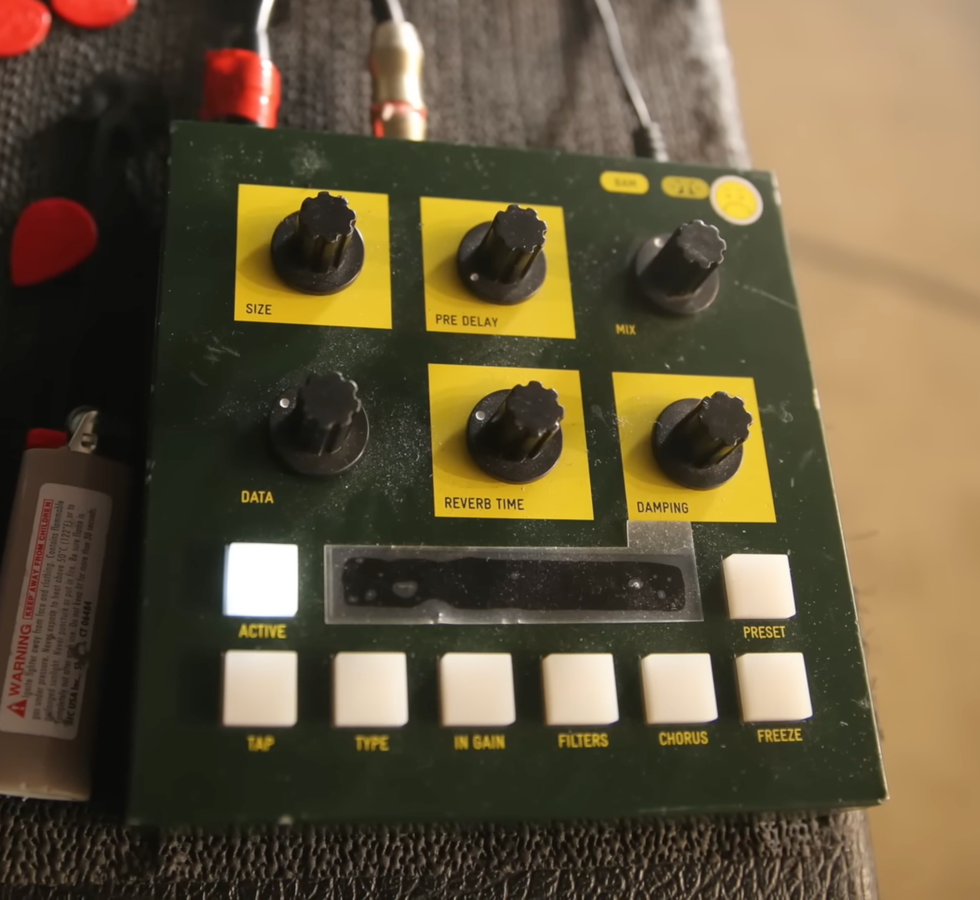
Elevated off the stage floor and secured by a stand are O’Malley’s Roland RE-201 Space Echo and Oto Machines BAM Space Generator Reverb.
Greg Anderson’s Pedalboard
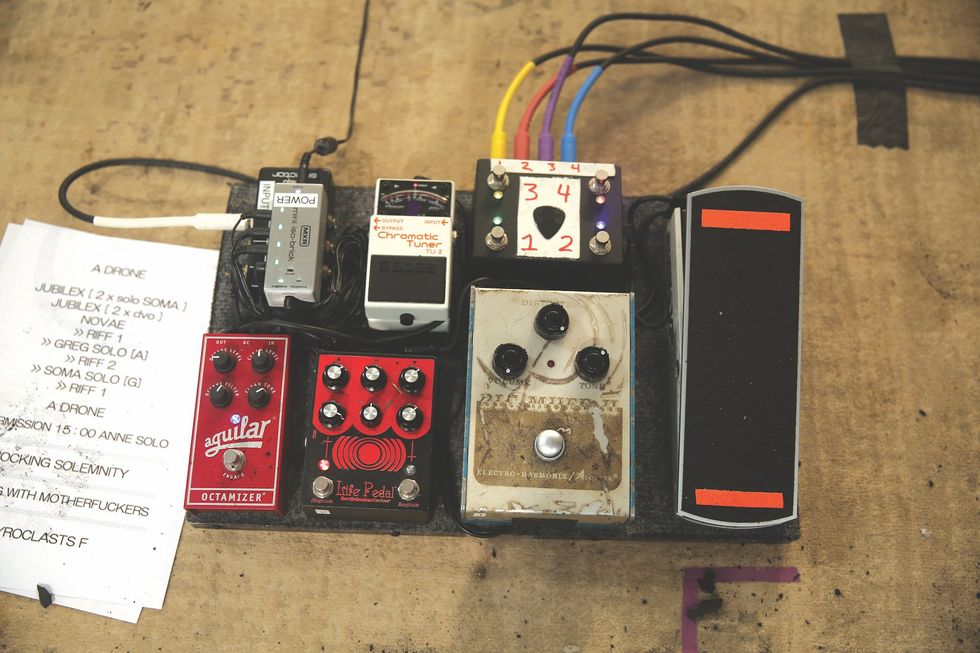
“To be honest with you, I try to keep it pretty simple now because I love pedals and have fallen down a lot of rabbit holes with them, but I found myself troubleshooting and having more issues than my sound warranted. When I started with this band, it was just a RAT and tuner pedal, so I try to just bring what I need,” says Anderson. He found a potent pairing with the EQD Life Pedal V2 acting as a boost and running into a vintage Electro-Harmonix Civil War Big Muff that creates a “powerful, chewy, ooze” tone. Like O’Malley, he also has a custom Bright Onion Pedals box and an Aguilar Octamizer set to unleash a “ridiculous, beating, fighting, chaotic, sub-bass sound.” An Ernie Ball VP JR handles dynamics, a Boss TU-2 Chromatic Tuner keeps his Les Paul in shape, and an MXR Mini Iso-Brick powers his pedals.
The Flaming Lips
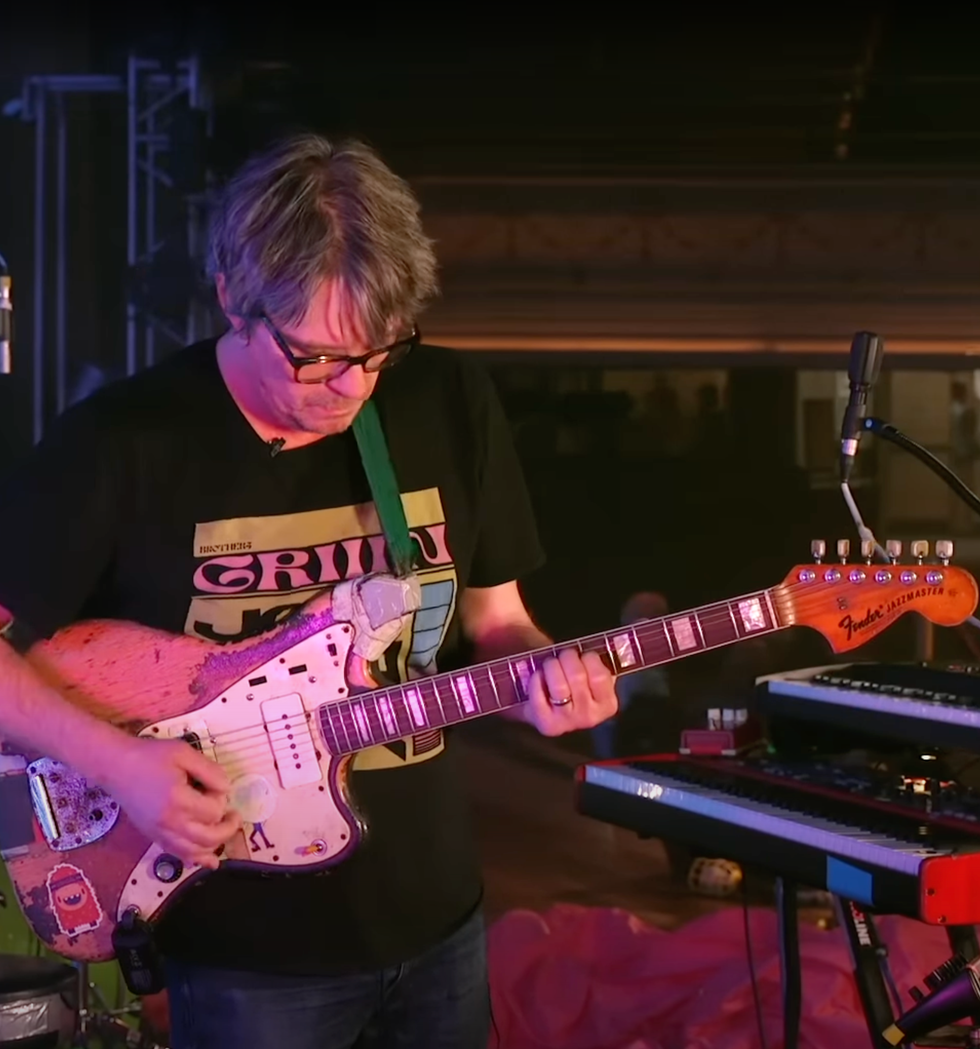
Steven Drozd’s Pedalboard
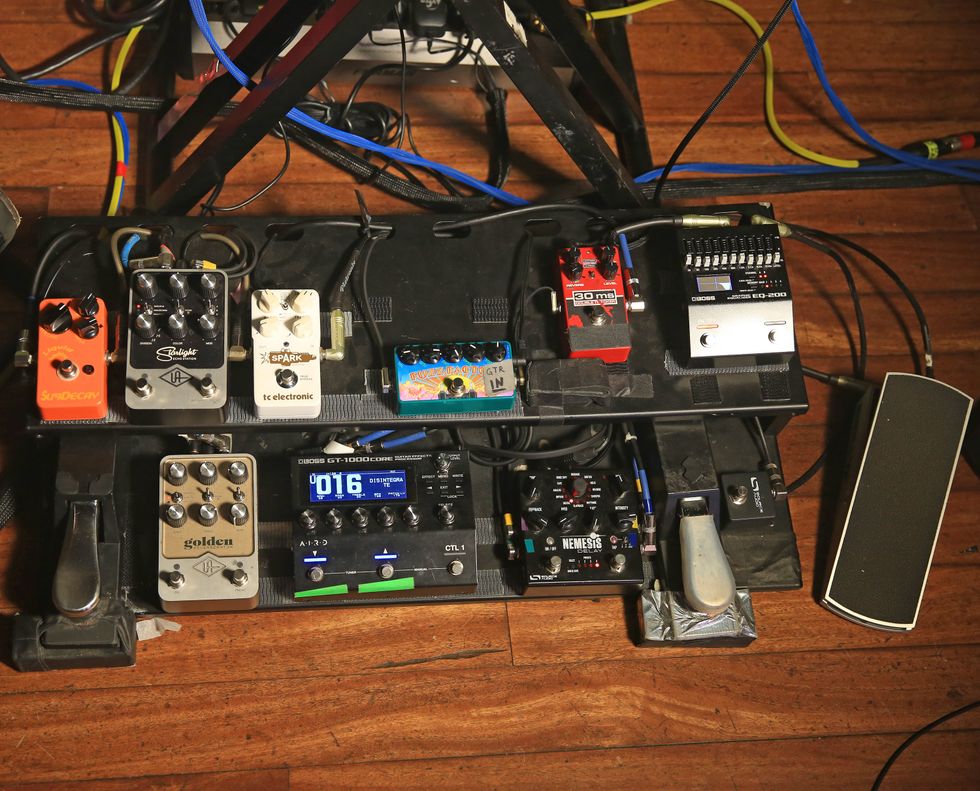
Given the nature of the Flaming Lips’ expansive and deranged sounds, you wouldn’t be blamed if you thought Drozd would have a rack of pedals or three tethered boards. But you’d be wrong—as he’s currently touring with nine stomps and an Ernie Ball volume pedal. Doing a lot of the heavy lifting is the Boss GT-1000CORE. The other sonic scalpels and sizzlers are a Subdecay Liquid Sunshine, a duo of Universal Audio units—a Starlight Echo Station delay and Golden Reverberator—a TC Electronic Spark Booster, a ZVEX Fuzz Factory, a Source Audio Nemesis Delay, a Keeley Electronics 30ms Automatic Double Tracker, and a Boss EQ-200 Graphic Equalizer.
Unknown Mortal Orchestra
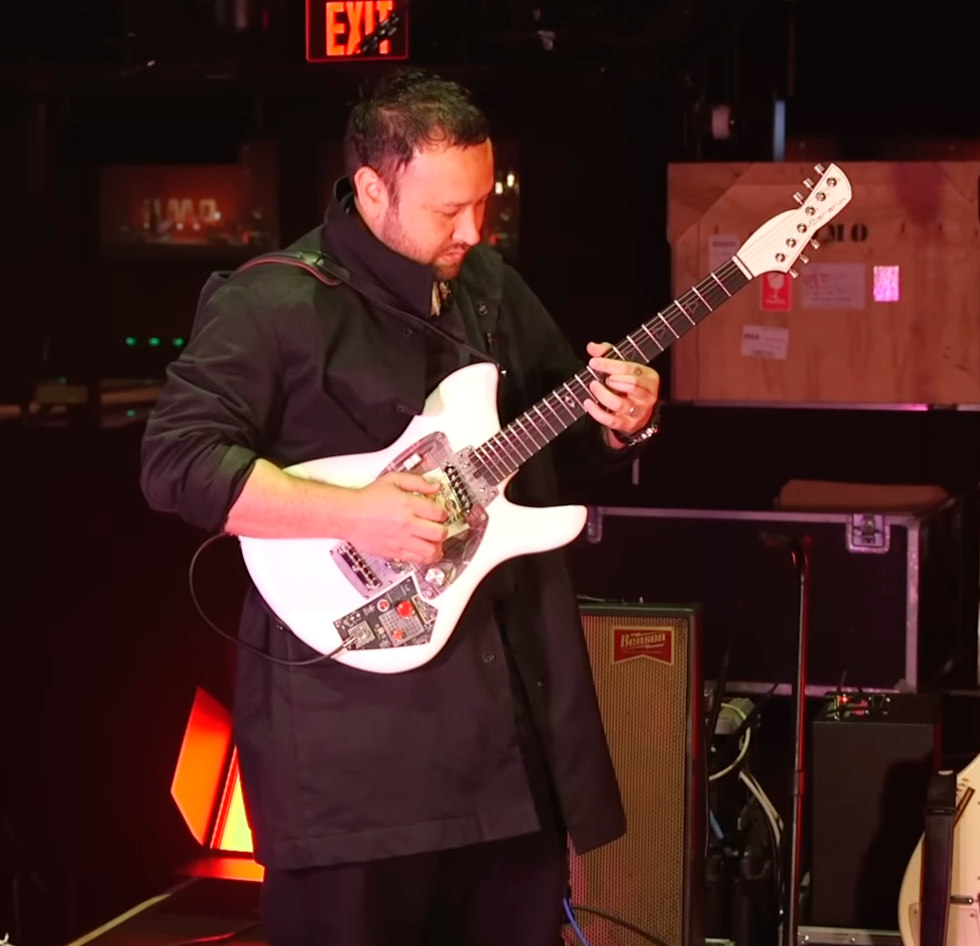
Ruban Nielson’s Pedalboard
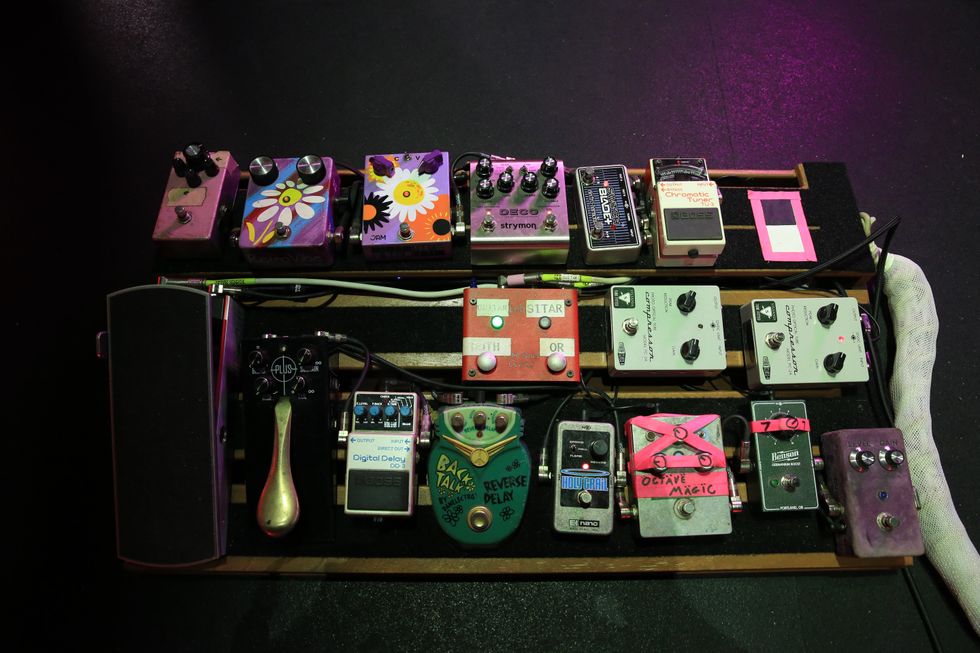
The New Zealand guitarist is a tone tactician. He’s never been satisfied with stock sounds and a pedal’s inherent limitations. “If I find a pedal I like, I use it for a long time and then I try to build a clone to see if I can improve on it,” he explains. “I sit around in my basement tweaking it plugged in—on the breadboard—and changing out different components and adjusting the trim until I get everything just exactly how I want it.” So, looking down at his stomp selection you’ll notice a few nondescript devices on the beautiful Twin Peaks Woodworks pedalboard custom-built by both Nielson’s tech Ben Gram and Caspian guitarist Jonny Ashburn.
His signal hits an Effectrode PC-2A Tube Compressor (you’ll notice two on the board—one is a backup). He enjoys how the PC-2A up front fattens his entire sound, and how it smooths and shaves off the transient tinges. The Strymon Deco has a stereo out that hits a pair of JAM Pedals RetroVibes. Both are set to have slightly different speeds and depths so that they really take that stereo signal for a journey in real time, and they’re panned in the PA to amplify this effect.
One of Nielson’s creations shows up inside the gray box titled “Octave Magic,” which is based on the Foxx Tone Machine. The suede purple devil next to it is the JAM Fuzz Phrase LTD, about which Nielson says, “It’s the wooliest, most musical Fuzz Face I’ve ever played.” Sometimes the answer to Nielson’s problems is the Benson Germanium Boost. “If something’s wrong,” he explains, “I’ll kick on that pedal and it makes everything louder and resets the gain structure.” The Gamechanger Audio Plus pedal sees a lot of action throughout the set: It helps Nielson seam the tail end of a solo and discreetly rejoin the band in rhythm mode.
The remaining pedals include a Boss DD-3 Digital Delay (a gift from Mike Baranik), a Danelectro Back Talk reverse delay, an Electro-Harmonix Holy Grail reverb, and in the top-left corner, an unnamed pedal that Nielson built that is currently not in the signal. (He can’t remember if it’s a RAT or Tube Screamer clone.) Utility boxes include a Boss TU-3 Chromatic Tuner, an Electro-Harmonix Switchblade Plus channel selector, and a Lehle Little Dual II switcher.
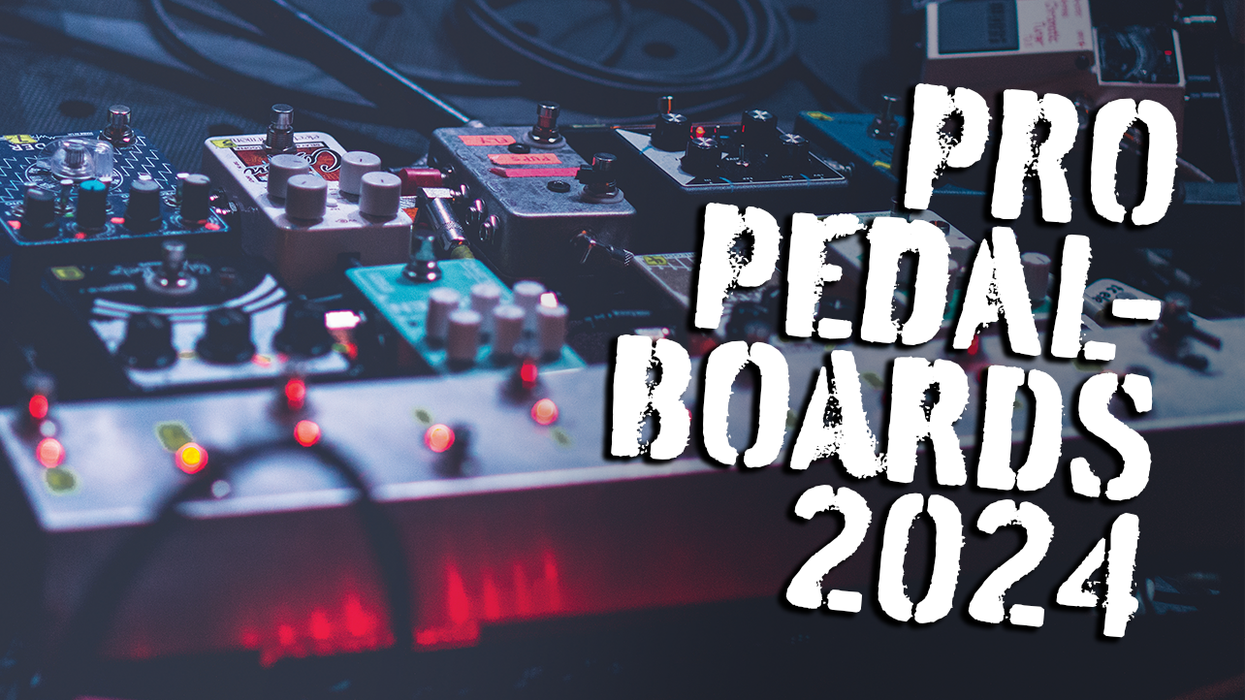
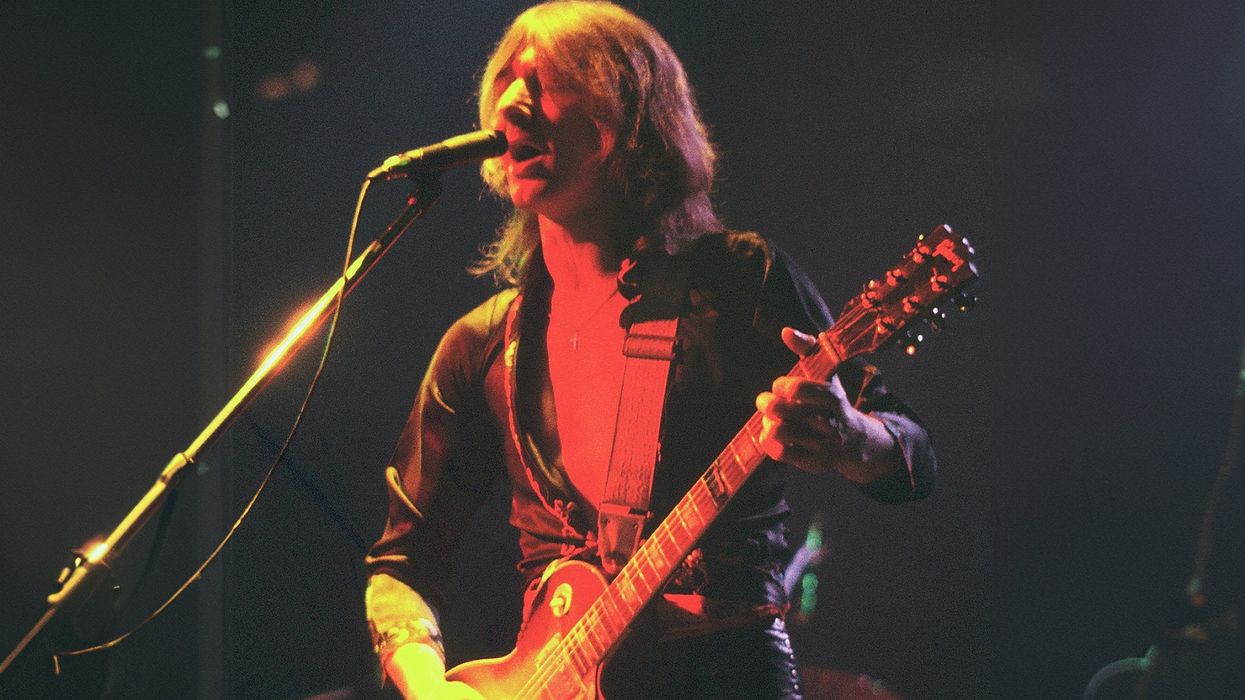
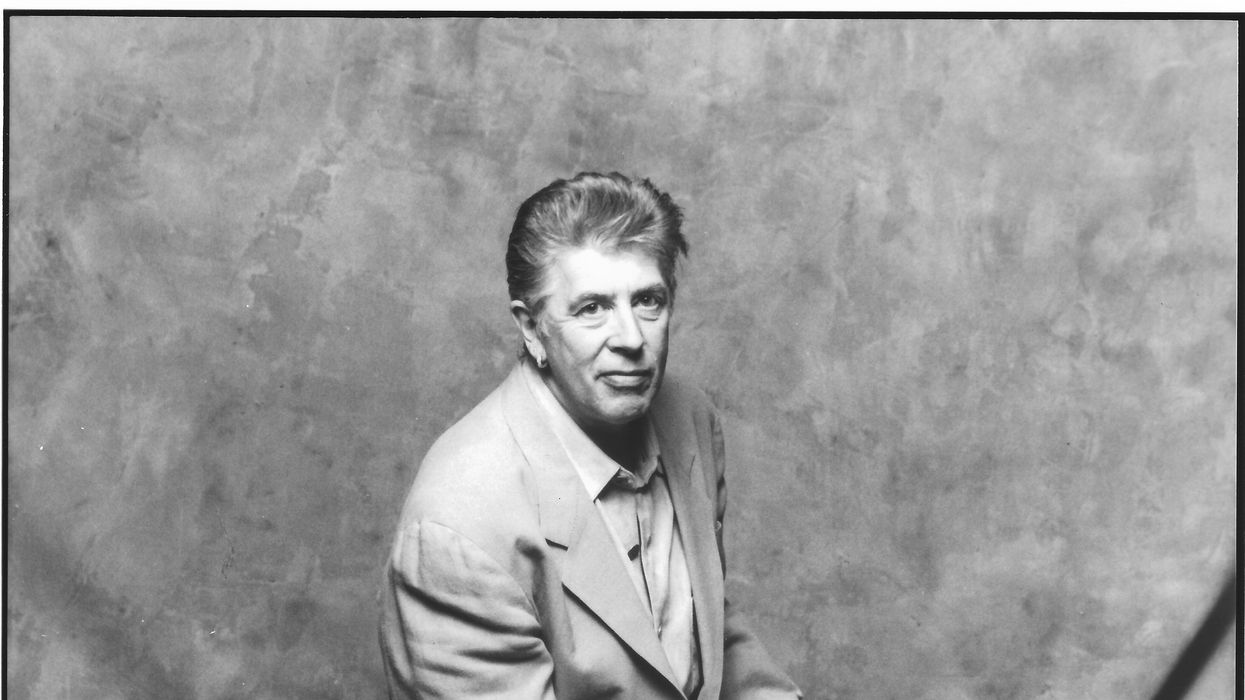
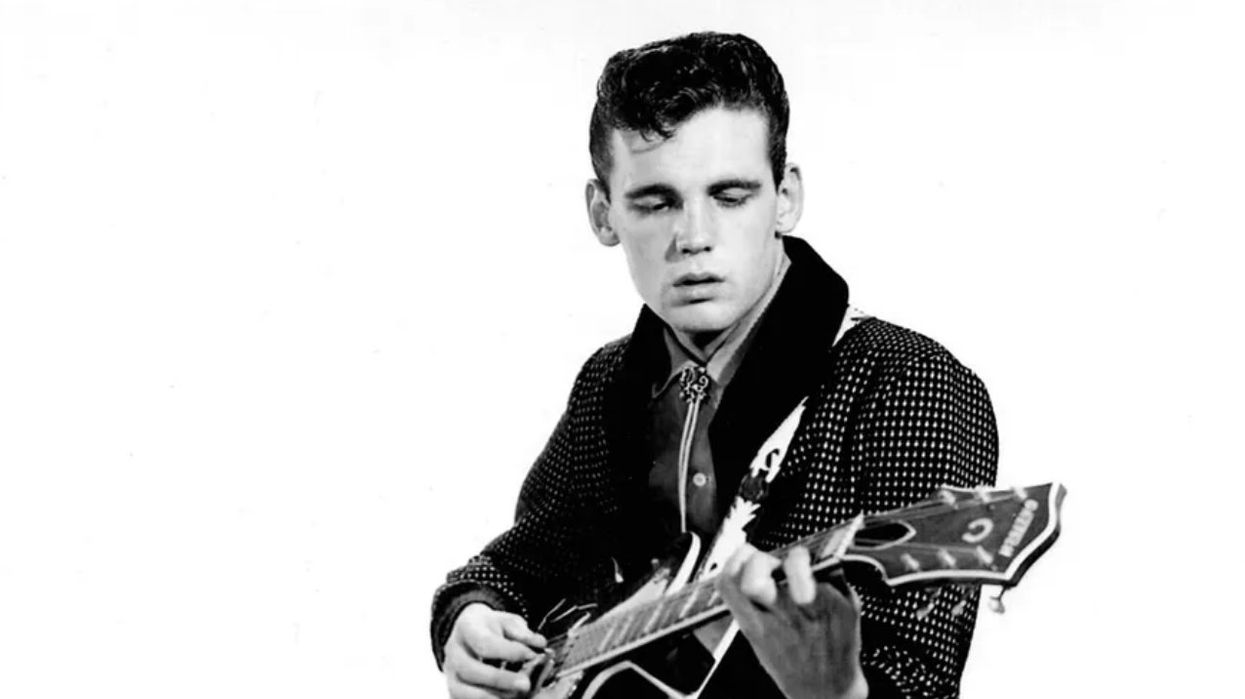
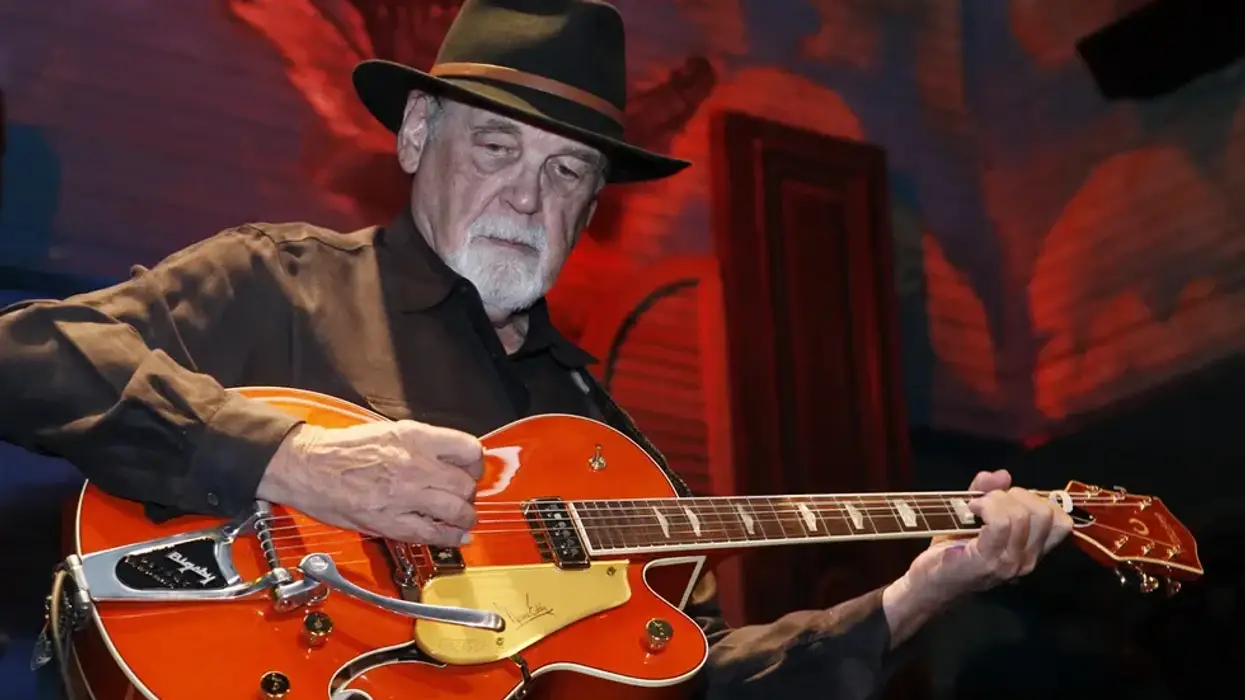
![Rig Rundown: Russian Circles’ Mike Sullivan [2025]](https://www.premierguitar.com/media-library/youtube.jpg?id=62303631&width=1245&height=700&quality=70&coordinates=0%2C0%2C0%2C0)
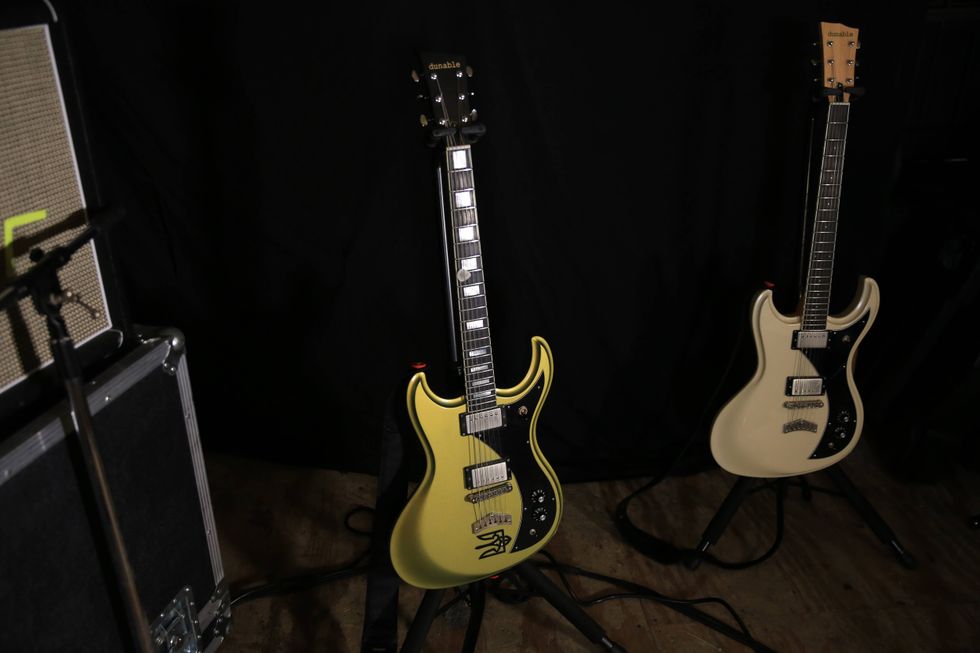
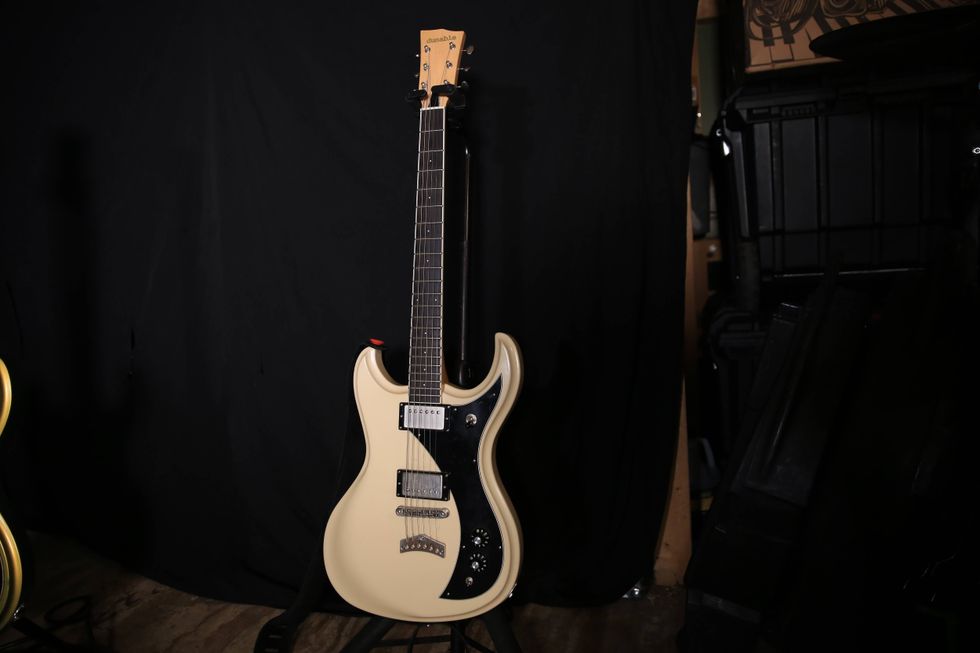
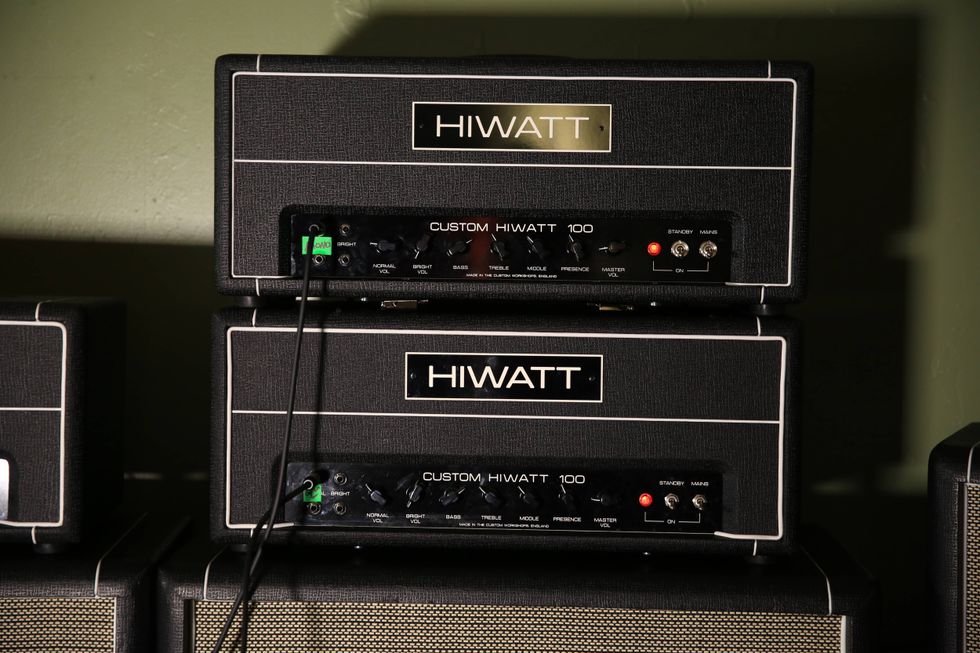
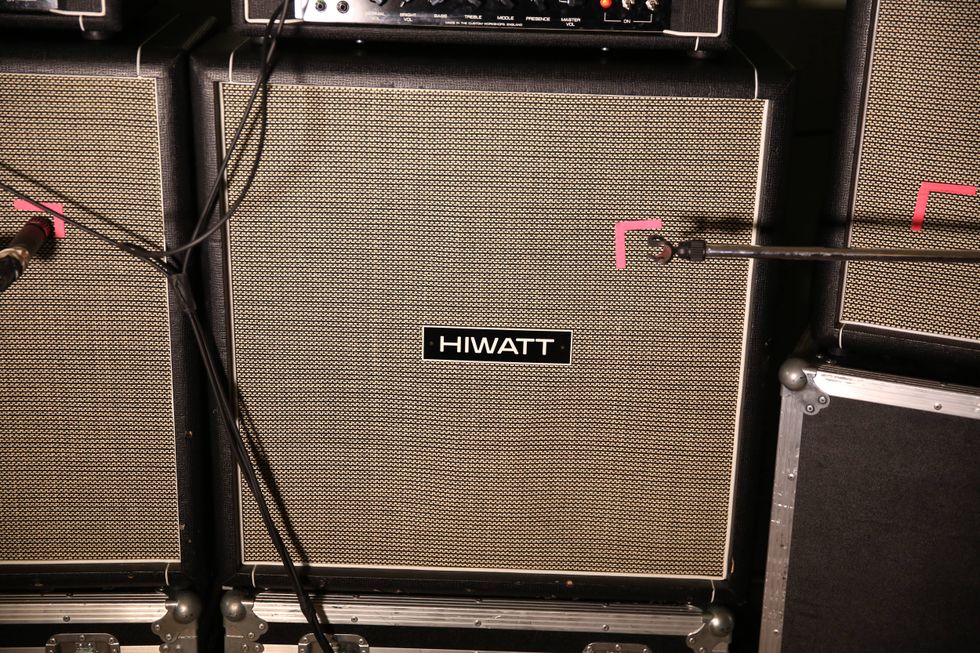
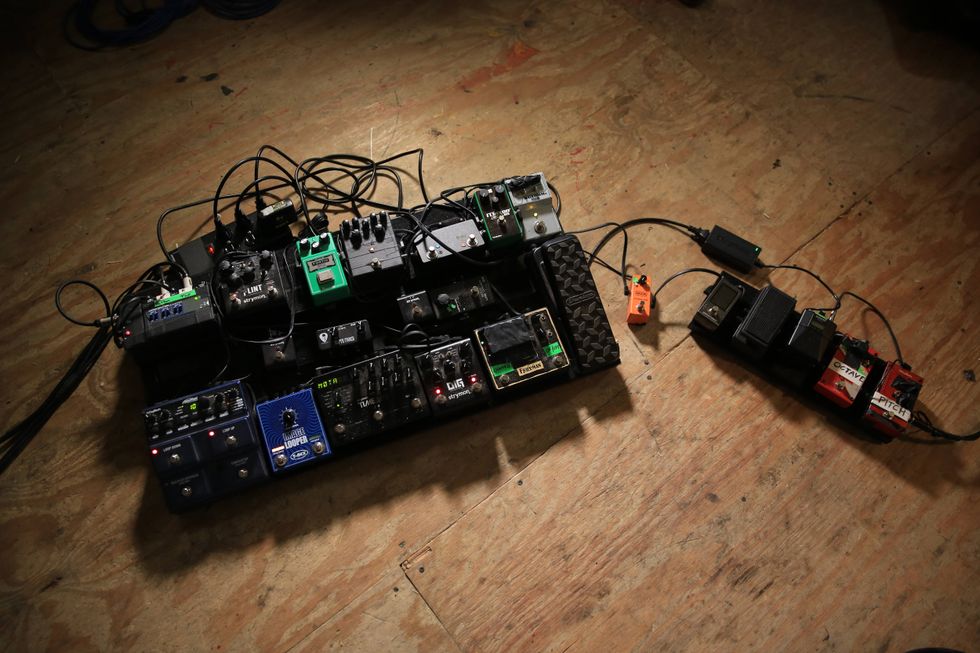

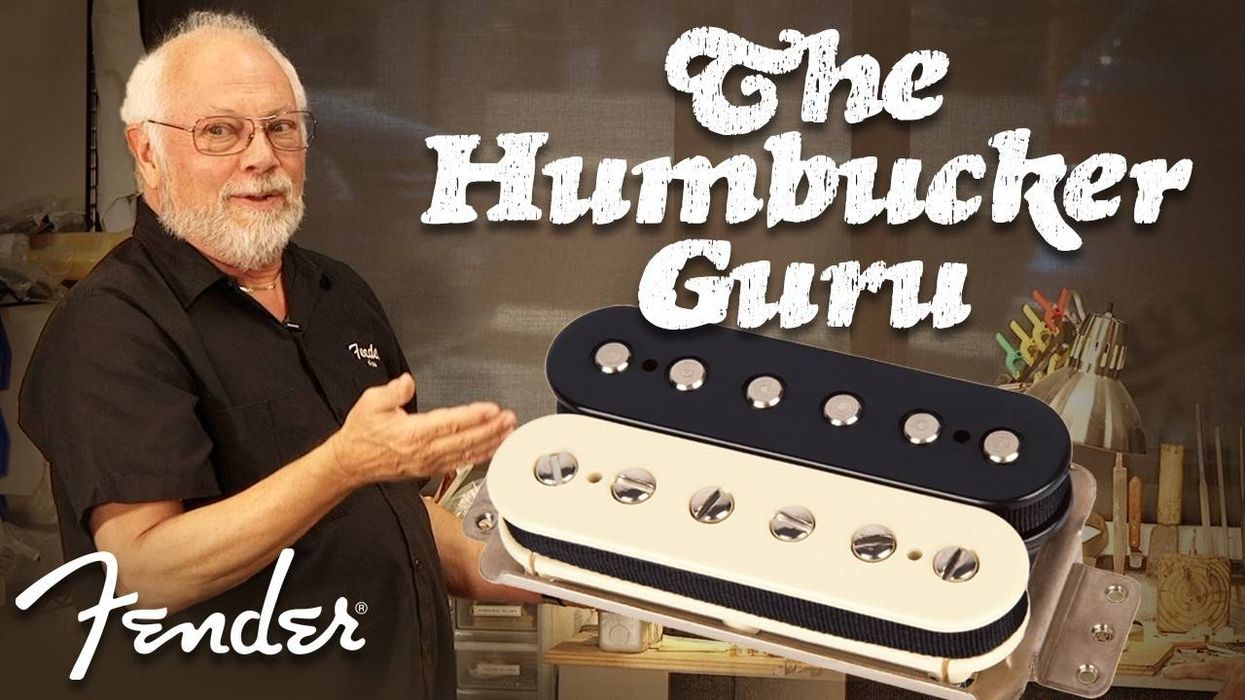
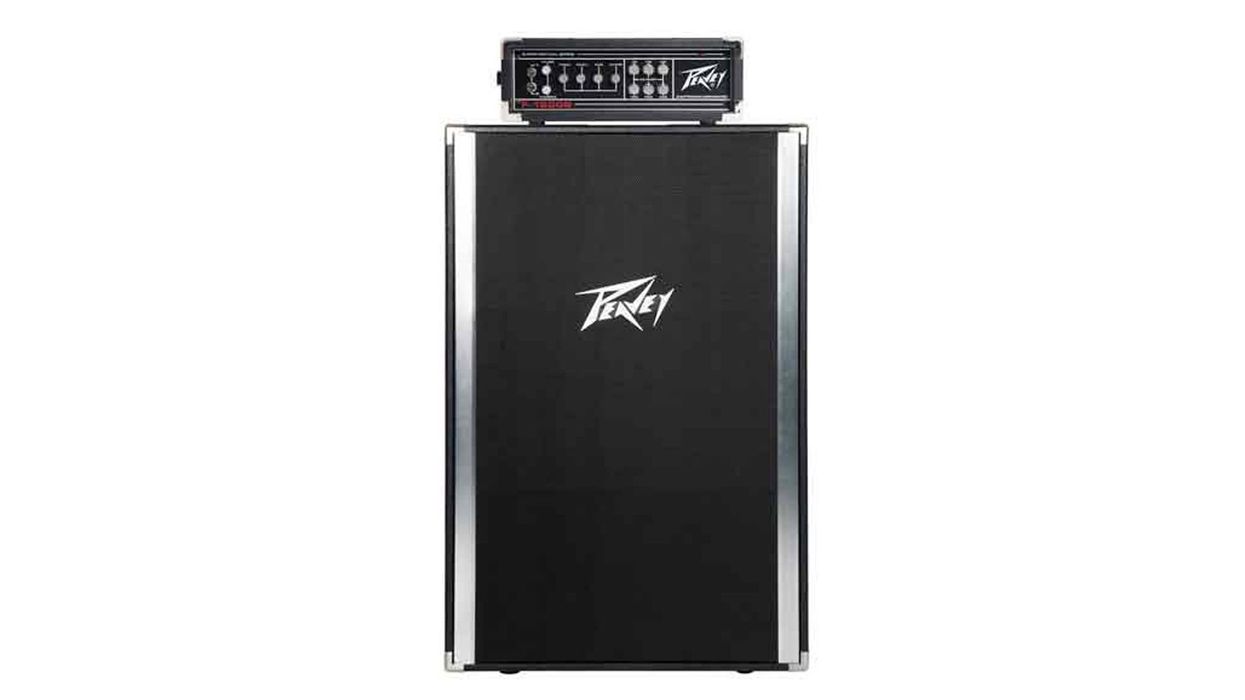
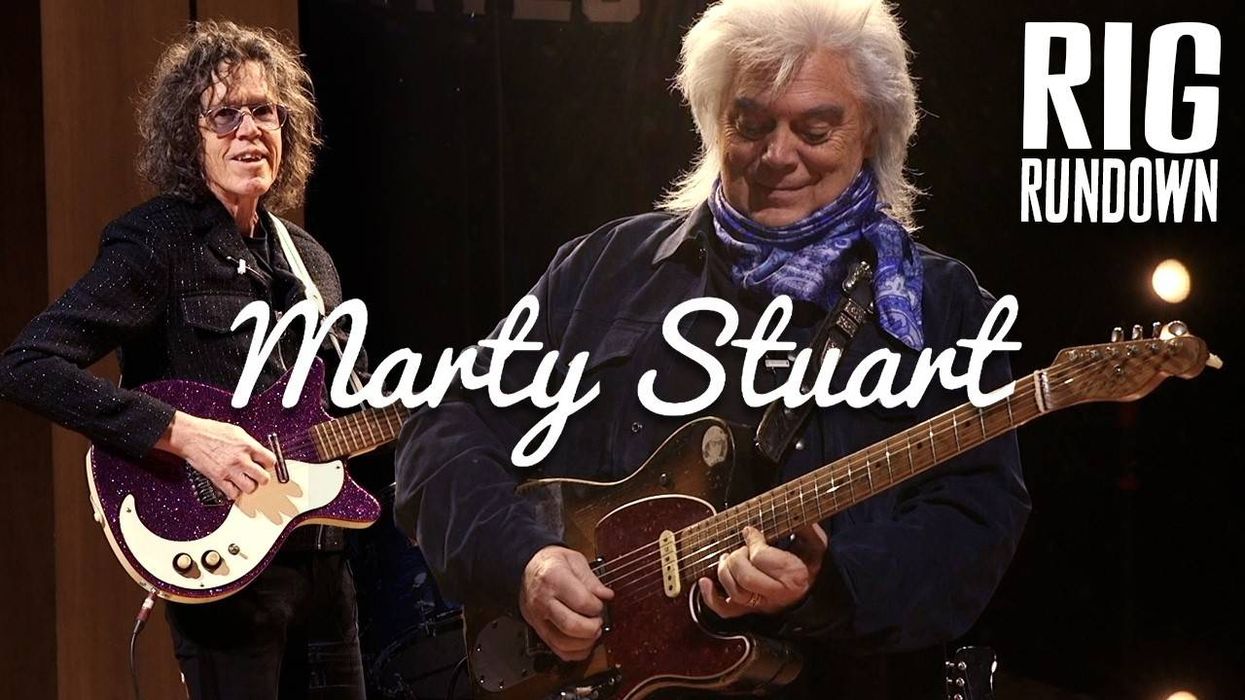

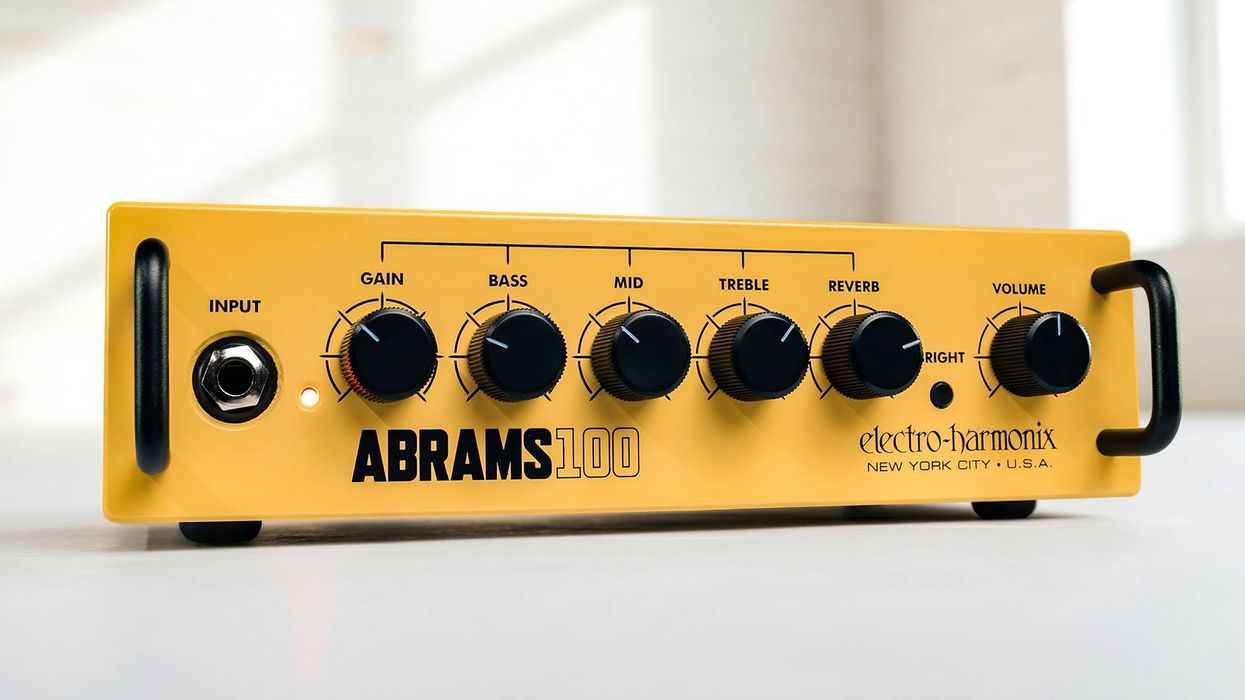
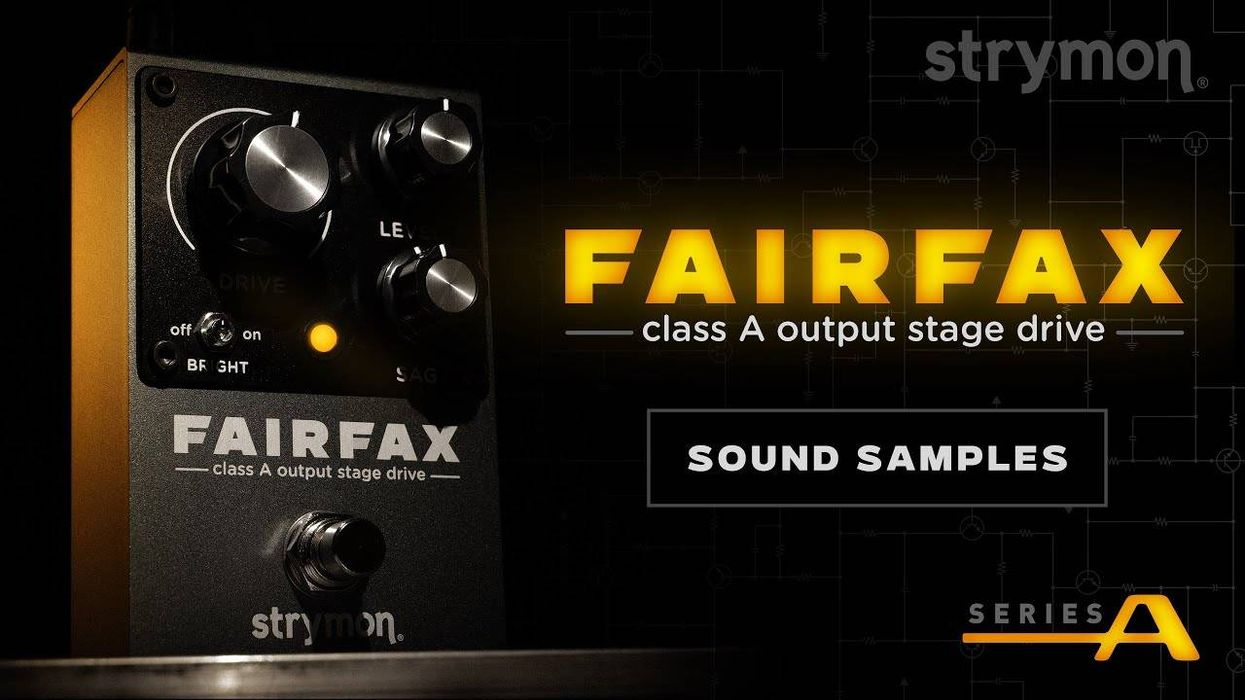
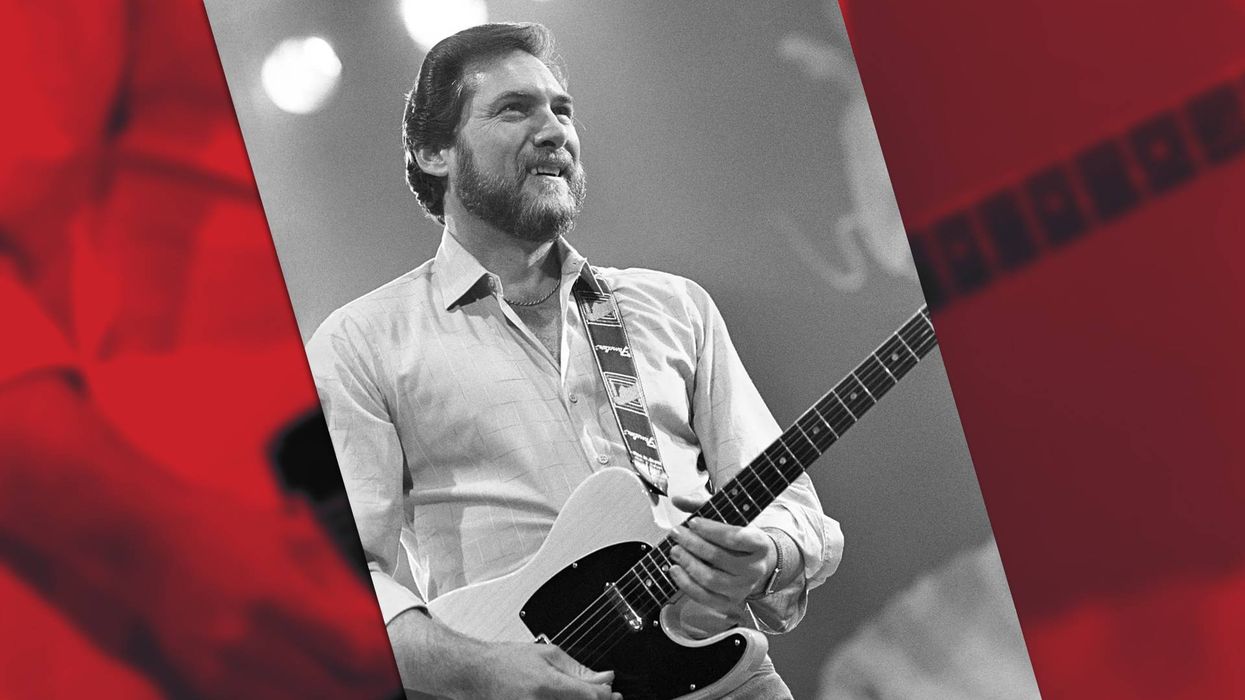
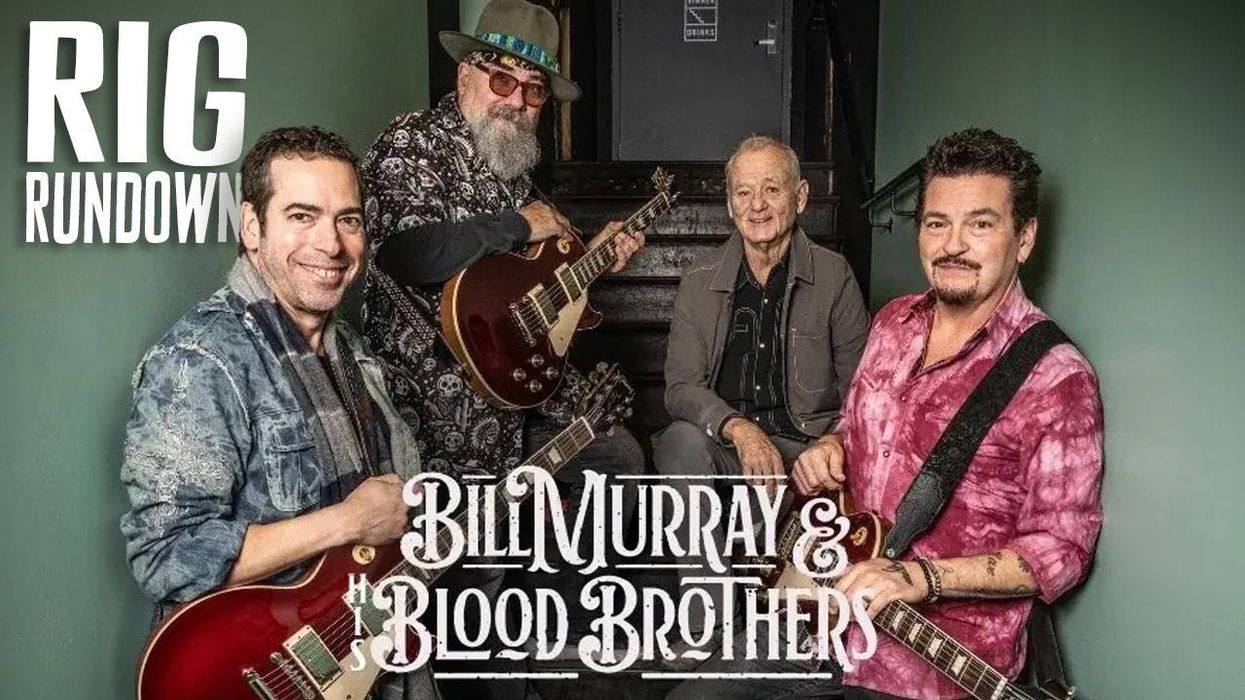
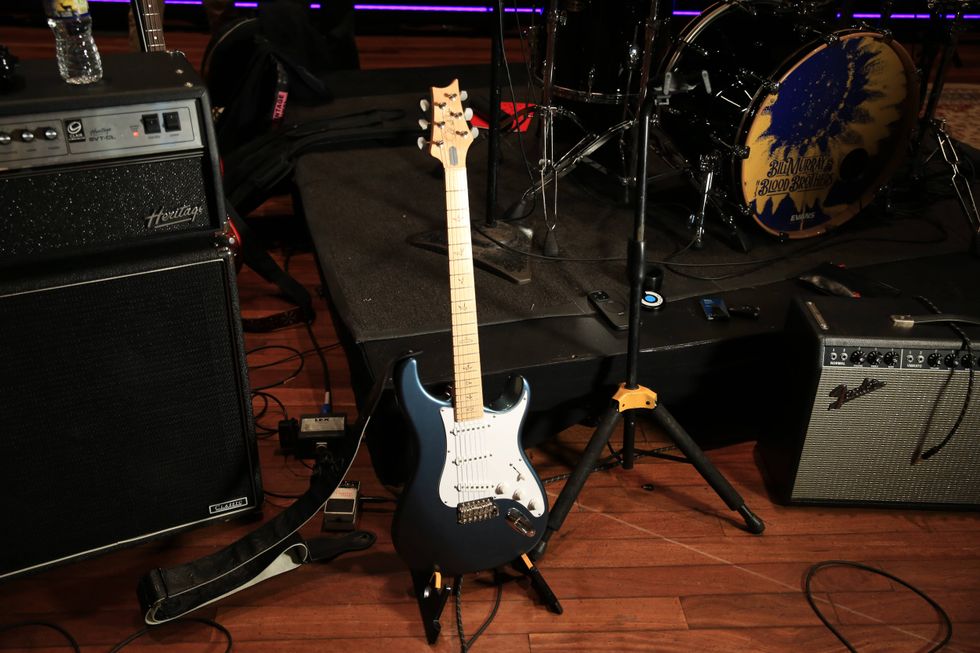
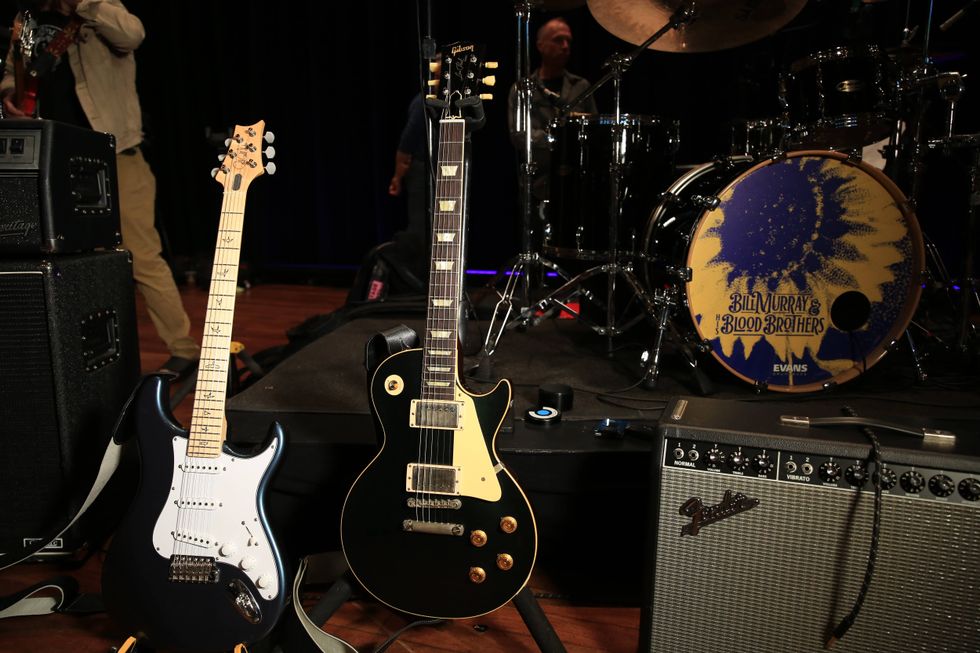
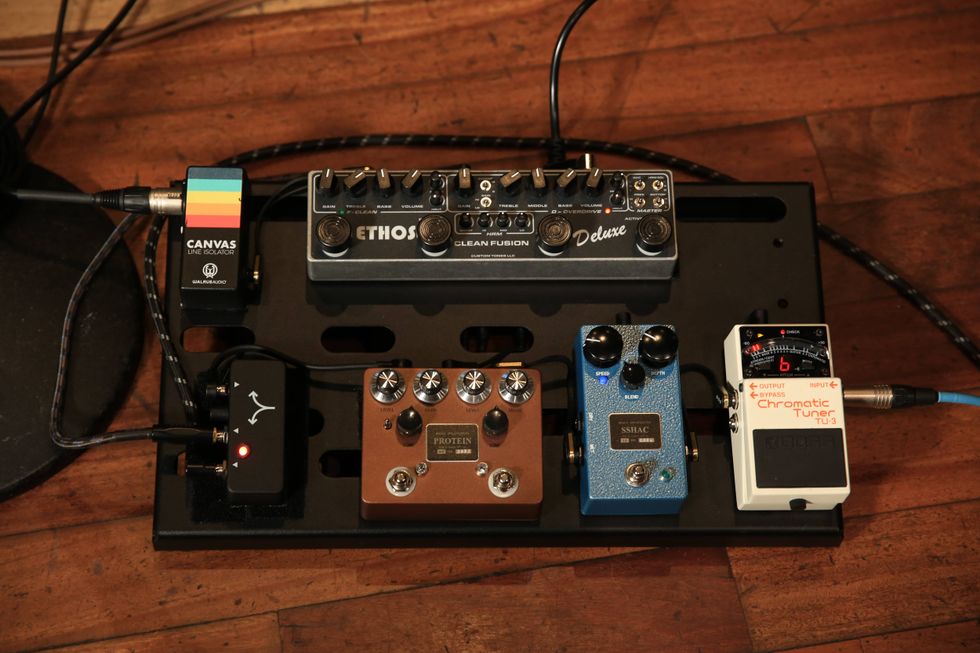
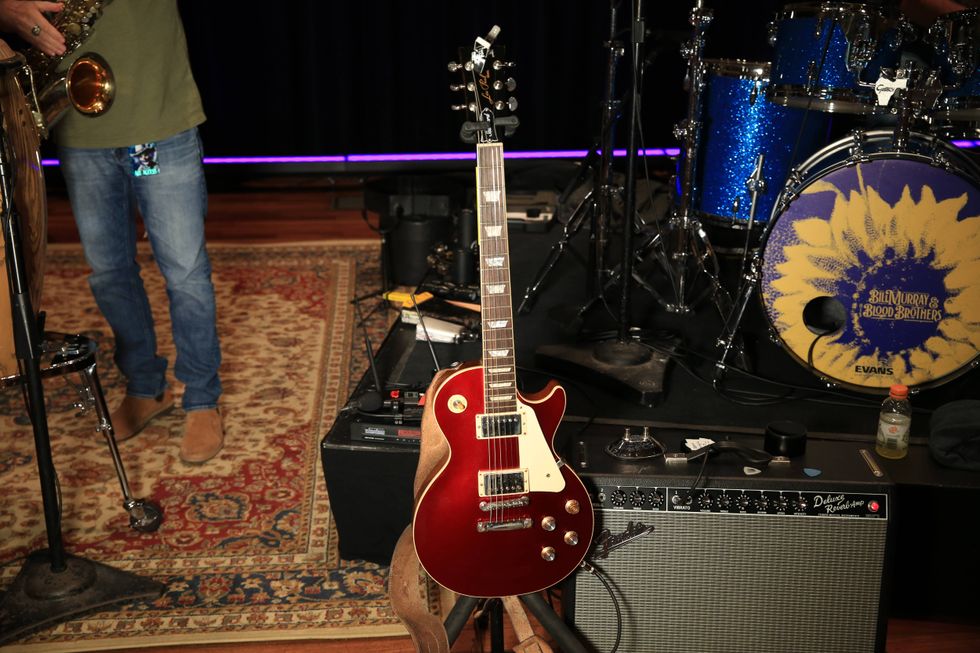
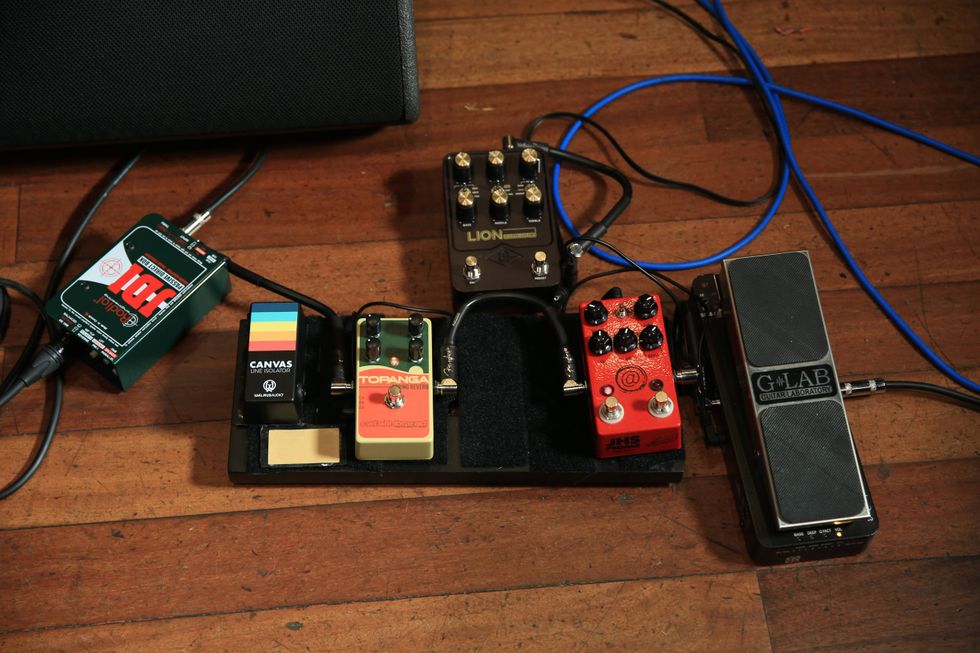
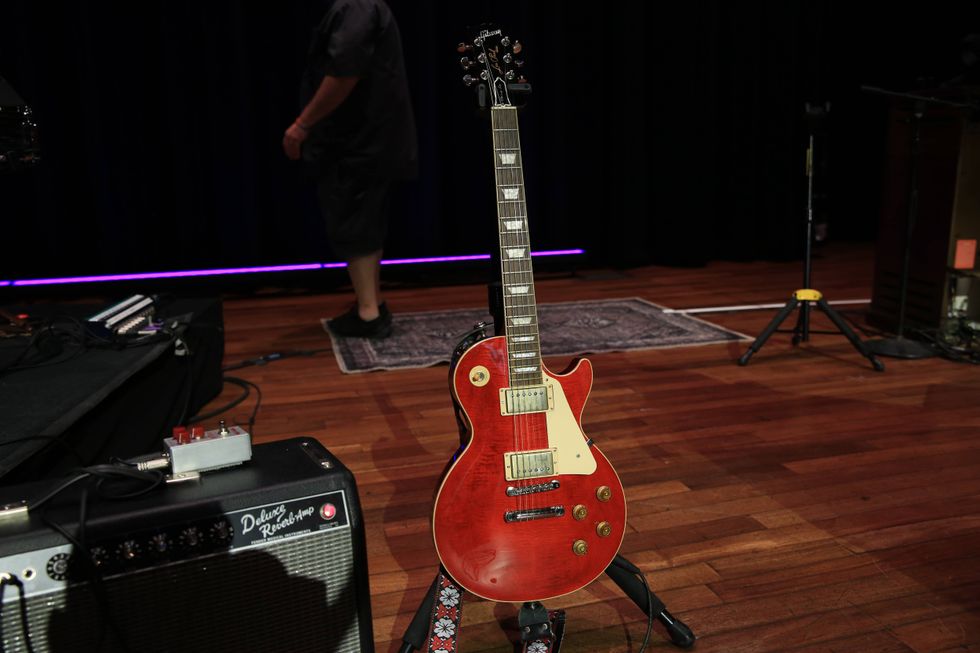
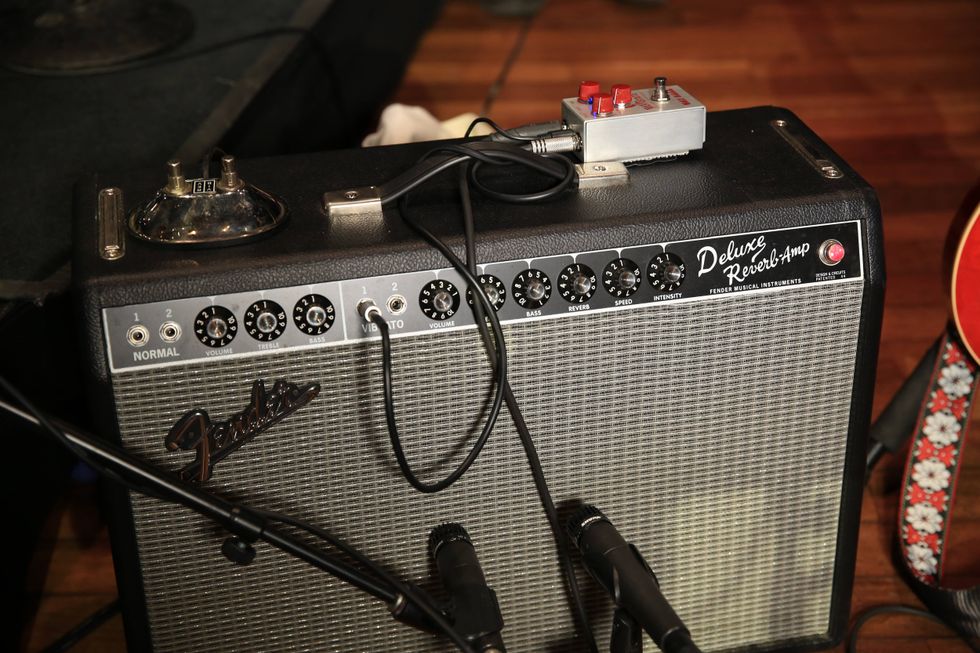
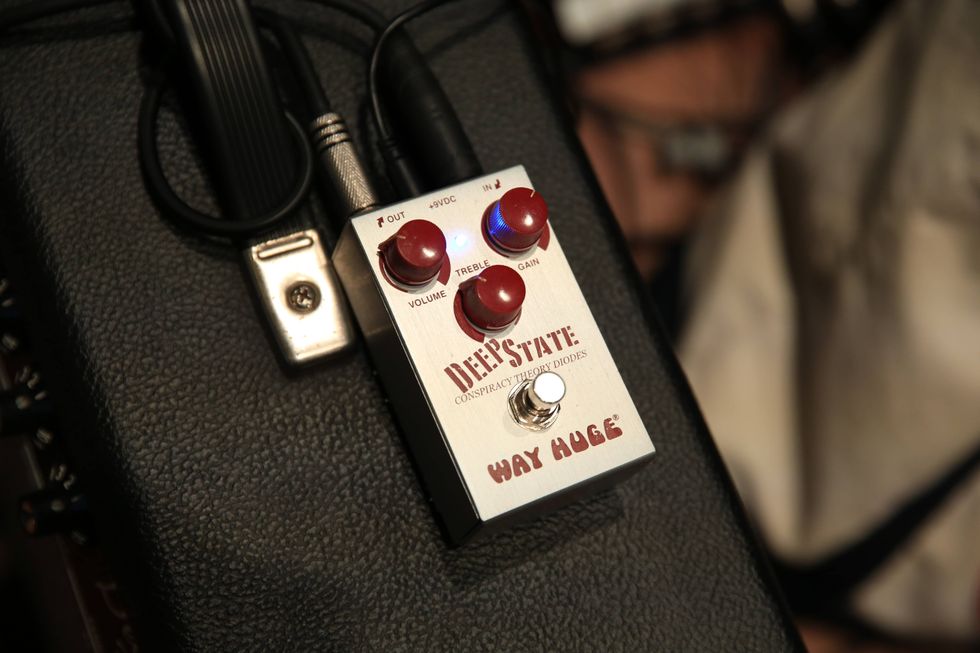

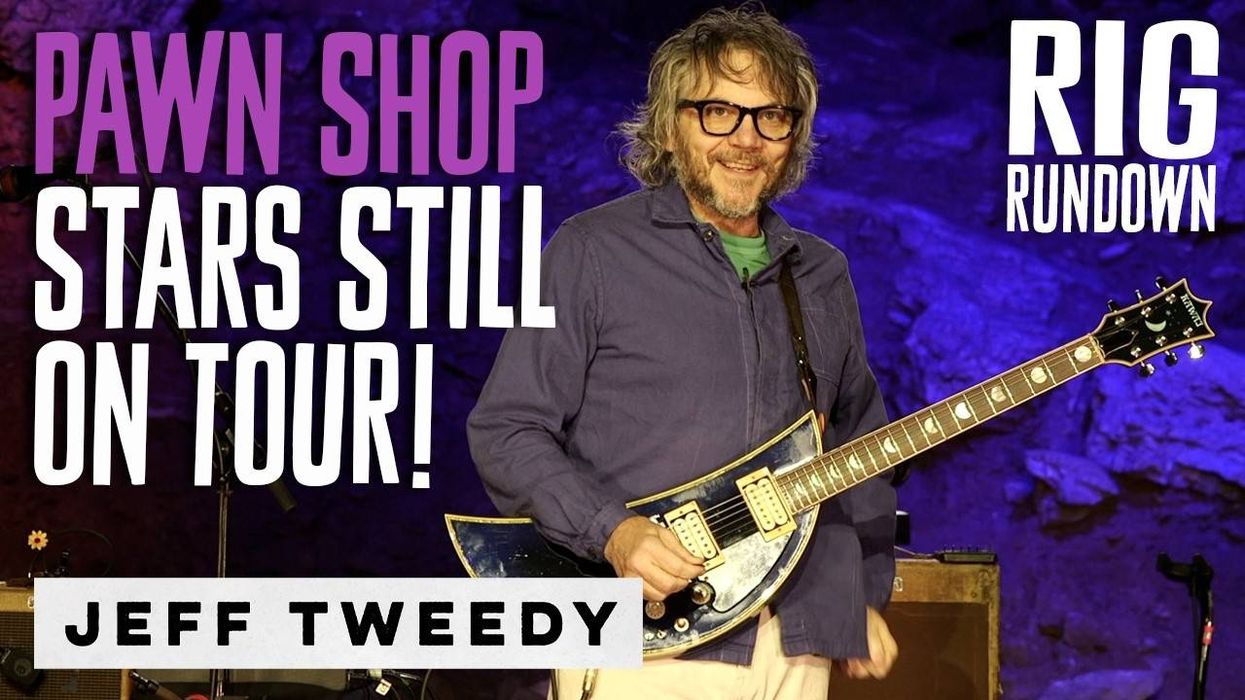
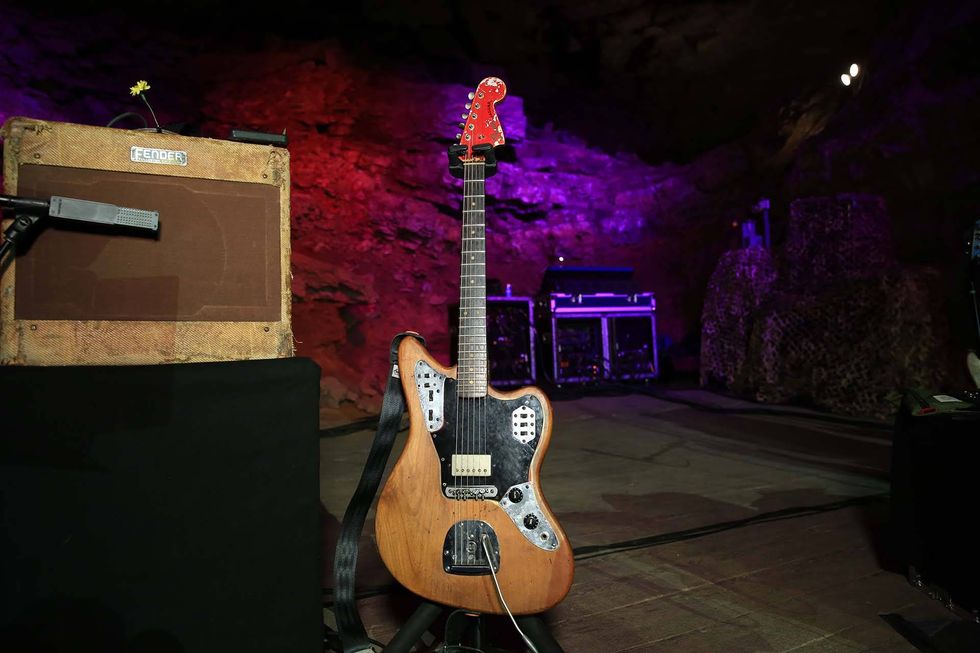
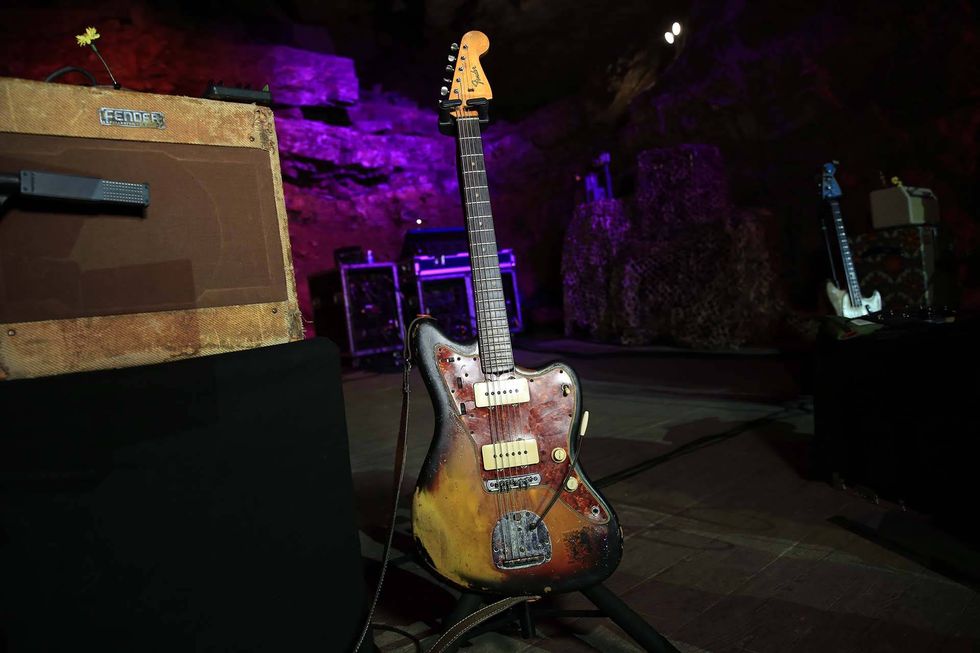
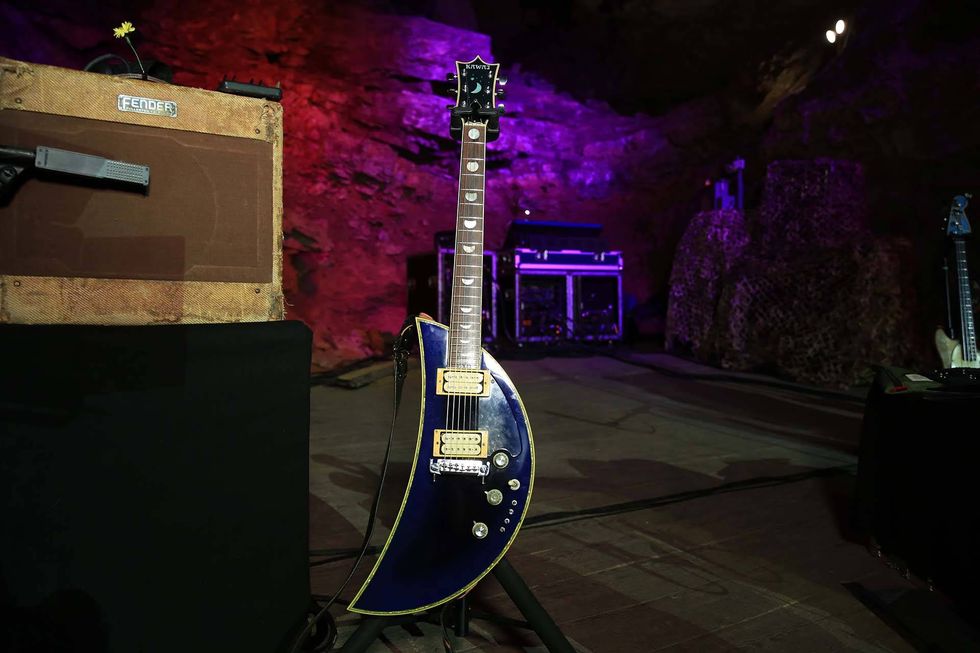
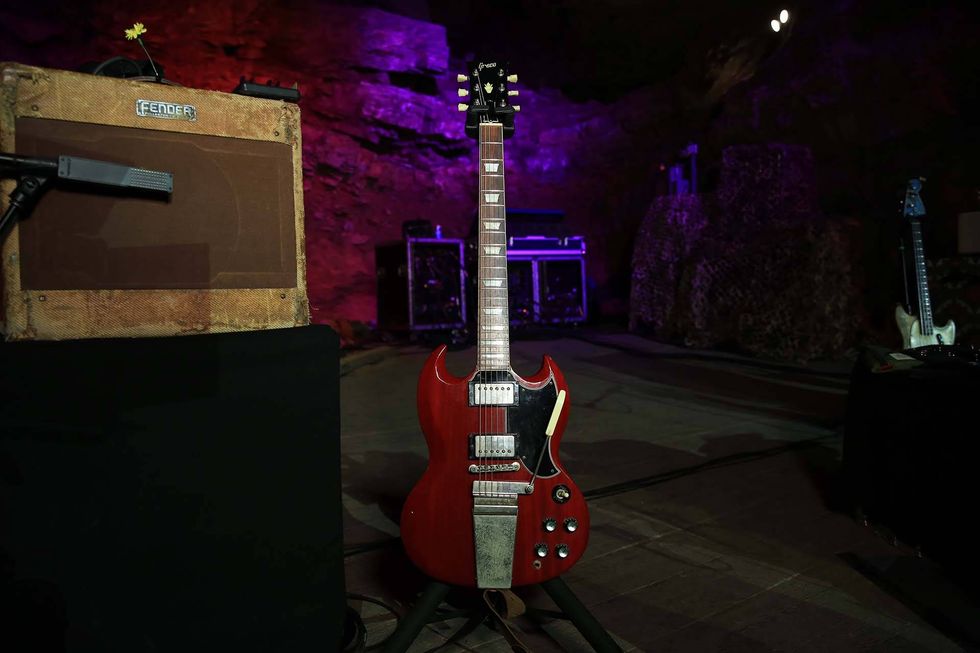
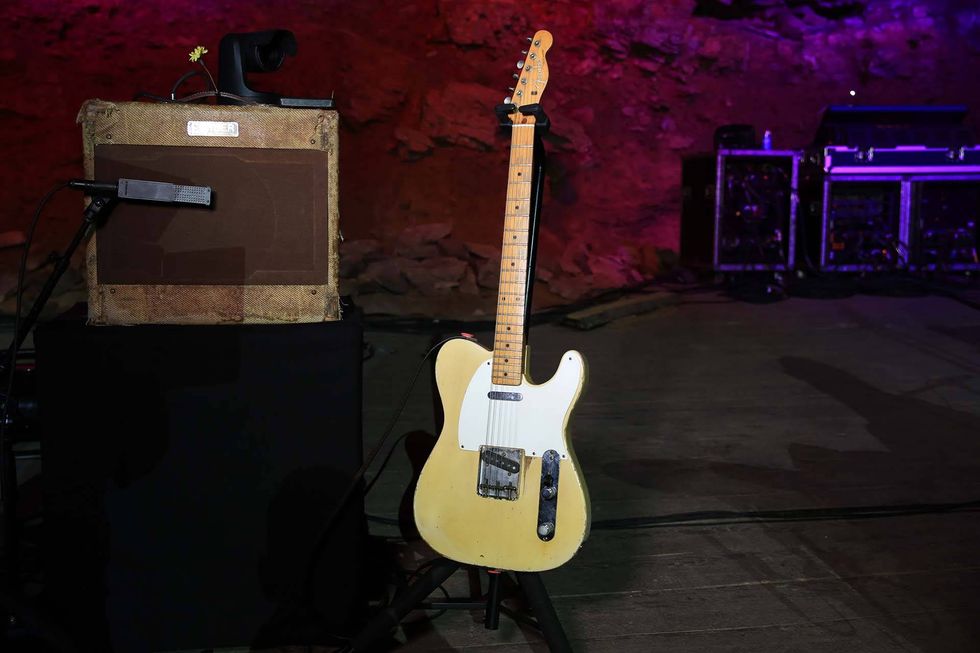
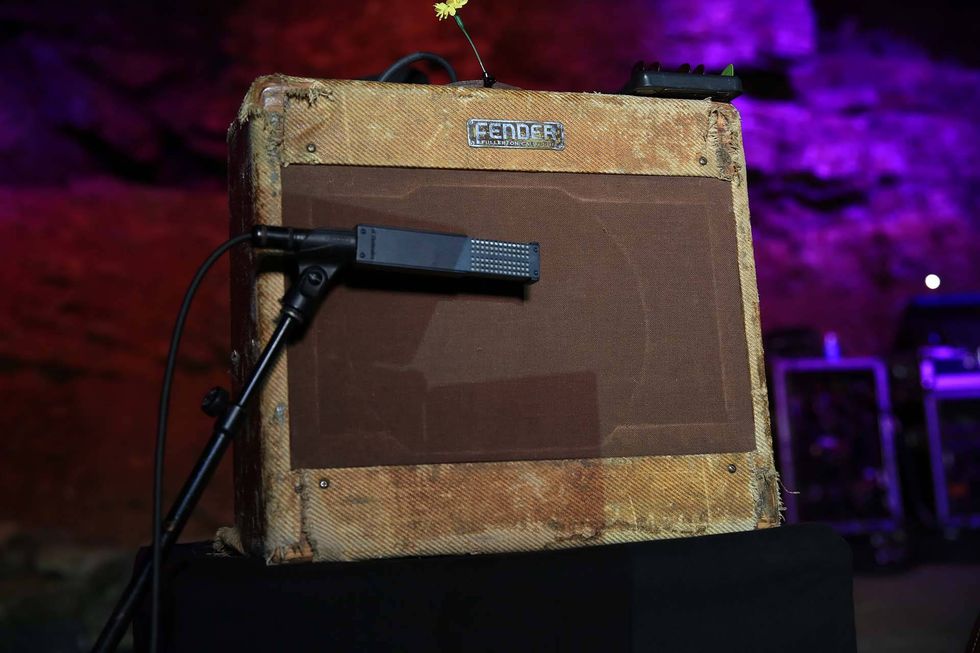
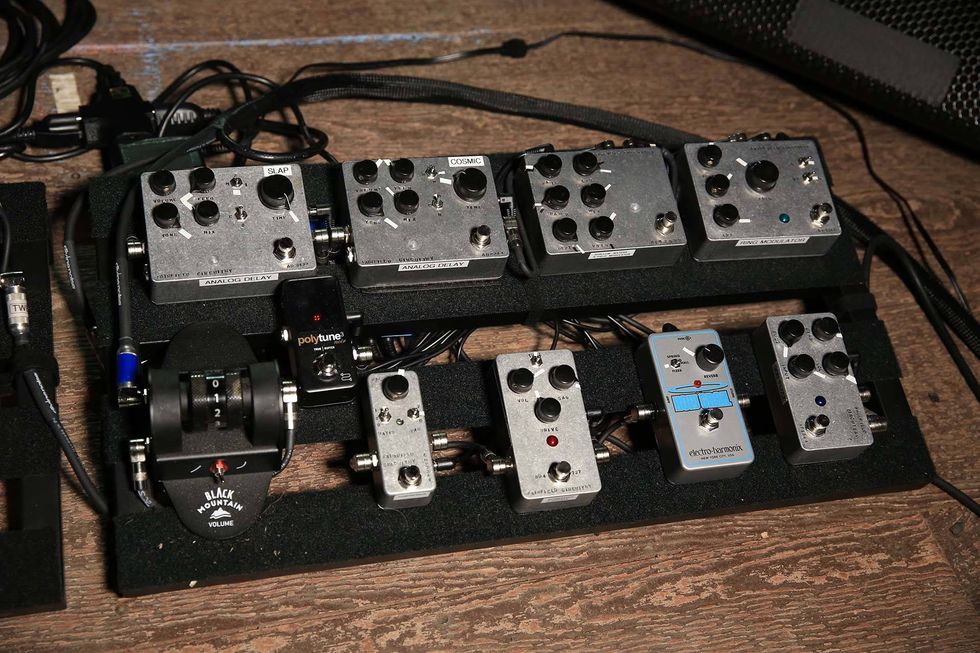
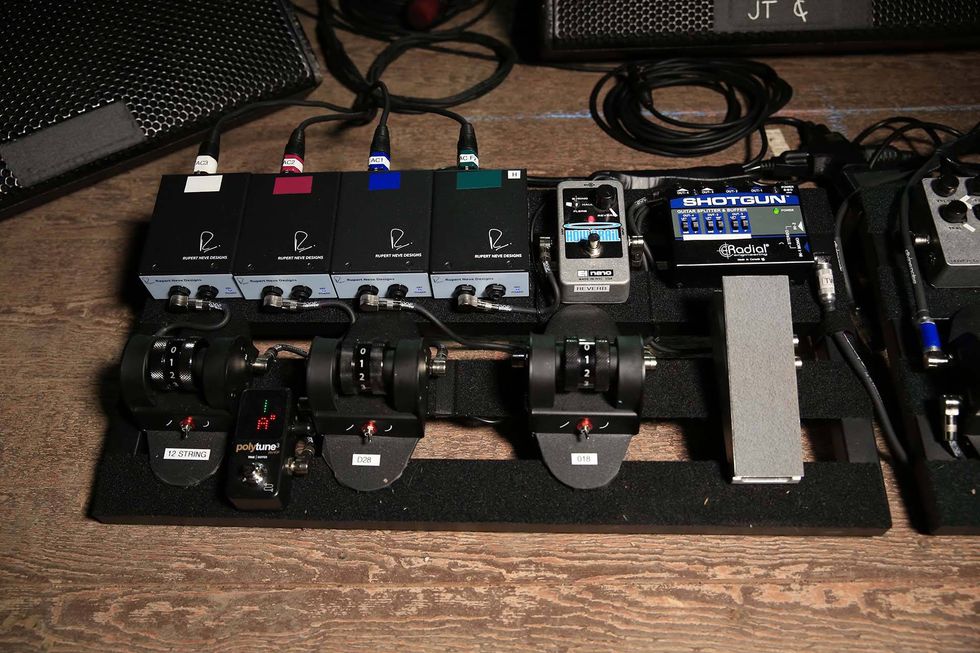
![Rig Rundown: AFI [2025]](https://www.premierguitar.com/media-library/youtube.jpg?id=62064741&width=1245&height=700&quality=70&coordinates=0%2C0%2C0%2C0)
